Bridge Permit Application Guide (BPAG)
Bridge Permit Application Guide (BPAG)
BPAG COMDTPUB P16591 3D_Clean_Final
Bridge Permit Application Guide (BPAG)
OMB: 1625-0015
OFFICE
OF BRIDGE PROGRAMS, U.S. COAST GUARD Bridge
Permit Application
OFFICE
OF BRIDGE PROGRAMS, U.S. COAST GUARD Bridge
Permit Application 


Guide
Guide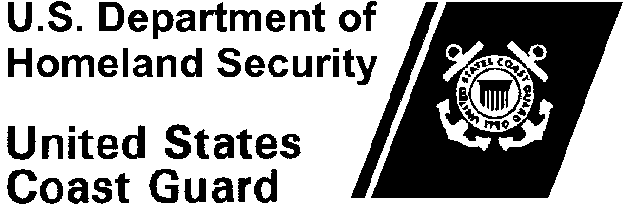


COMDTPUB P16591.3E
June 2024
OMB Control Number: 1625-0015
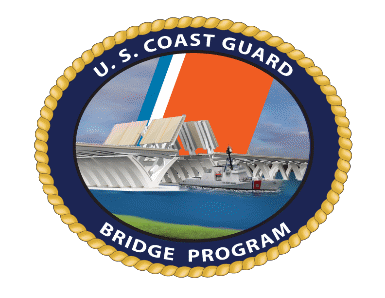
Commandant |
US COAST GUARD STOP 7710 2703 MARTIN LUTHER KING JR AVE, SE Staff Symbol: CG-BRG
|

DD MMM YYY
COMMANDANT publication p16591.3E
-
Subj:
BRIDGE permit application guide
Ref: (a) 33 C.F.R. Chapter 1-Coast Guard, Subchapter J-Bridges, Parts 114-118
(b) U.S. Coast Guard Environmental Planning Policy, COMDTINST 5090.1 (series)
PURPOSE. This Publication has been prepared to assist bridge owners applying for a Coast Guard permit to construct a new bridge or causeway or reconstruct or modify an existing bridge or causeway across the navigable waters of the United States in accordance with Reference (a).
ACTION. All Coast Guard unit commanders, commanding officers, officers-in-charge, deputy/assistant commandants, and chiefs of headquarters staff elements shall comply with the provisions of this Publication.
AUTHORIZED RELEASE. This publication is authorized for internet release.
PUBLICATIONS AFFECTED. This Publication supersedes the previous Bridge Permit Application Guide, COMDTPUB P16591.3D, hereby cancelled.
DISCUSSION. Federal law prohibits the construction of any bridge across the navigable waters of the United States unless first authorized by the Coast Guard. This Publication is available on the Coast Guard Office of Bridge Programs website (URL) and shall be provided to State or local agencies who routinely apply for bridge permits and to other prospective applicants when requested. Following the procedures in this Publication will expedite the bridge permitting process. Questions regarding a specific project should be directed to the Bridge Program staff of the Coast Guard District where the project is located. Contact information for the District Bridge Offices are in Appendix F of this publication and on the Coast Guard’s Bridge Program website.
DISCLAIMER. This guidance is not a substitute for applicable legal requirements, nor is it itself a rule. It is intended to provide administrative guidance for Coast Guard personnel and is not intended nor does it impose legally-binding requirements on any party outside the Coast Guard.
MAJOR CHANGES. Previously the information requested from this Publication duplicated the information found in the Bridge Permit Application Template. The duplicate information was removed from this Publication and the Bridge Permit Application Template is now included as Appendix B. Additional appendices were added for the Coast Guard Bridge Plan Sheet Job Aid and the Coast Guard Bridge Lighting Guide, and the appendix for the bridge plan sheet samples was expanded to include additional samples for better clarity and accuracy.
The Permit Application Template has been changed to reflect the way the Coast Guard documents this information in its internal case record of file. The Environmental Documentation section was updated to ensure all Bridge Program actions conform with the most up to date National Environmental Policy Act (NEPA) guidance, currently U.S. Coast Guard Environmental Planning Policy, (COMDTIST 5090.1 (series)), to simplify the documentation requirements, and to better align with the requirements found in the Coast Guard Bridge Program prepared Findings of Fact.
SCOPE AND AUTHORITIES. It is recommended the reader become familiar with the directives and publications noted throughout this Instruction including the following:
Environmental Planning Program, Department of Homeland Security (DHS) Directive 023-01 (series);
U.S. Coast Guard Environmental Planning Policy, COMDTINST 5090.1 (series), U.S. Coast Guard Environmental Planning Implementing Procedures;
Council on Environmental Quality, Regulations for Implementing the Procedural Provisions of the National Environmental Policy Act, 40 C.F.R. §§ 1500–1508;
Implementation of the National Environmental Policy Act (NEPA), DHS Instruction Manual 023-01-001-01 (series);
All applicable Executive Orders and Acts affecting the environmental review for the permitting of infrastructure.
IMPACT ASSESSMENT. This Publication does not require any new action by the district bridge offices that is not already part of the permit application process. It is an information collection tool for bridge permit applicants. There are no new personnel resources required, no new training and no funding considerations.
ENVIRONMENTAL ASPECTS AND IMPACT CONSIDERATION.
The Office of Environmental Management, Commandant CG-47 reviewed the development of this Publication, and the general policies contained within it, and determined that this policy falls under the Department of Homeland Security (DHS) categorical exclusion A3.
This Publication will not result in any substantial change to existing environmental conditions or violation of any applicable federal, state, or local laws relating to the protection of the environment. It is the responsibility of the action proponent to evaluate all future specific actions resulting from this policy for compliance with the National Environmental Policy Act (NEPA), other applicable environmental mandates, and the U.S. Coast Guard Environmental Planning Policy, (COMDTIST 5090.1 (series).
DISTRIBUTION. No paper distribution is available for this Publication. Electronic versions of this Publication and its appendices (A - Waterway Data Requirements; B - Bridge Permit Application template; C - Bridge Permit Plan Sheet Job Aid; D - Plan Sheet Samples; E - Environmental Control Laws and regulations; F - District Bridge Office Contacts; G - District Map; and H - Bridge Lighting Guide) is located on the following Commandant (CG-612) web sites. Internet: www.dcms.uscg.mil/directives, and CGPortal: https://uscg.sharepoint-mil.us/sites/USCGReferences/directives/SitePages/HomeHome.aspx.
RECORDS MANAGEMENT CONSIDERATIONS. Records created as a result of this Instruction, regardless of format or media, must be managed in accordance with the records retention schedule located on the Records Resource Center SharePoint Online site: https://uscg.sharepoint-mil.us/sites/cg61/CG611/SitePages/Home.aspx.
CUSTOMIZED POLICY PARAGRAPHS. None.
FORMS/REPORTS. None.
SECTION 508. This Instruction was created to adhere to Accessibility guidelines and standards as promulgated by the U.S. Access Board. If changes are needed, please communicate with the Coast Guard Section 508 Program Management Office at [email protected].
REQUEST FOR CHANGES. Send changes/recommendations to: [email protected].
MICHAEL D. EMERSON
Senior Executive Service, U. S. Coast Guard
Director, Marine Transportation Systems
Table of COntents

Section 1 Introduction To The Permitting Process 1
C. Preliminary Navigation Clearance Determination 2
D. NEPA Scoping, Drafting and Evaluation Phase 2
F. Permit Application Review and Public Notice 3
G. Permit Decision & Case File Submission 3
Section 2 Bridge Project Initiation Request 5
A. Bridge Project Initiation Request For Permit 5
B. Bridge Proejct Initiation Request Submission And Evaluation 5
Section 3 Permit Application 7
Appendix A: Waterway Data Requirements A-1
Appendix B: Bridge Permit Application B-1
A. The Application Package B-1
B. Waterway Data Requirements: B-9
C. Environmental Documentation: B-9
Appendix C: Bridge Permit Plan Sheet Job Aid C-1
Appendix D: Plan Sheet Samples D-1
APPENDIX G: Coast Guard District Bridge Program Office Contacts G-1
sECTION 1 INTRODUCTION TO THE PERMITTING PROCESS
The Coast Guard Bridge Program ensures marine safety, security, and stewardship and contributes to the freedom of navigation and the nation’s Marine Transportation System through its authority to approve the location and plans of all new bridges, modifications of existing bridges and causeways in or over navigable waterways of the United States, and international bridges across waterways.
Authority for the permitting process is found in 33 U.S.C. § § 401, 491, 525-533, the International Bridge Act of 1972 and various acts of Congress. Pursuant to the Rivers and Harbors Act, 33 U.S.C. § 401 “No bridge shall at any time unreasonably obstruct the free navigation of any navigable waterway of the Unites States.” In addition, per 33 U.S.C. § 494 “No bridge erected or maintained under the provisions of sections 491 to 498 of this title, shall at any time unreasonably obstruct the free navigation of the waterway over which it is constructed.”
The Coast Guard permits the location and plans of bridges and causeways and imposes any necessary conditions relating to the construction, maintenance, and operation of these bridges in the interest of public navigation. A bridge permit is the written approval of the location and plans of the bridge or causeway to be constructed or modified across a navigable waterway of the United States. It is important to understand the next opportunity to adjust clearances for navigation is usually between 50-100 years.
Additional information regarding Coast Guard permitting is available online at https://www.dco.uscg.mil/Office-of-Bridge-Programs/. Federal law prohibits the construction of bridges and causeways across navigable waterways unless the Coast Guard first authorizes them.
This guidance does not substitute applicable legal requirements, nor does it create a rule. It is neither intended to, nor does it impose legally-binding requirements on any party. It represents the Coast Guard’s current guidance on this topic and may assist industry, mariners, the public, and the Coast Guard, as well as other federal and state regulators, in applying statutory and regulatory requirements. In compliance with the Paperwork Reduction Act of 1995, the collection of this information for a bridge permit application is covered by Office of Management and Budget Control Number: 1625-0015.
THE PERMITTING PROCESS
The applicant contacts the applicable Coast Guard District Bridge Office to discuss the proposed bridge project and requirements in this Guide.
The Coast Guard District Bridge Office determines if the waterway is navigable (if not previously determined) and if the project is exempt from a Coast Guard bridge permit.
The applicant submits a project initiation request to the Coast Guard District Bridge Office. Information on the project initiation request is found later in this Guide.
When the Coast Guard is not the lead federal agency, the applicant provides information on the anticipated level of NEPA document, if known.
The Coast Guard District Bridge Office reviews the project initiation request and determines project viability and priority level.
The Coast Guard District Bridge Office provides points of contact and guidance to assist the applicant in preparing a Navigation Impact Report. See Appendix A for navigation impact report requirements.
Coordination Meetings
The applicant coordinates with the Coast Guard and other Federal, State, and local agencies to identify responsibilities, issues/concerns, need for public meetings, application requirements, and project schedule/milestones, etc. During this coordination, the following actions occur:
The lead Federal agency and any cooperating agencies are identified.
A determination of which agency is to act on behalf of other agencies for the Endangered Species Act, National Historic Preservation Act, etc.
The Coast Guard District Bridge Office provides written acceptance of cooperating/participating agency status to the lead Federal agency.
Preliminary Navigation Clearance Determination
Applicant submits Navigation Impact Report (when applicable).
Upon review of the Navigation Impact Report, the Coast Guard District Bridge Office provides a Preliminary Navigation Clearance Determination to the applicant in writing to inform project alternatives in the NEPA document. The determination will state how long it is valid if navigation does not change on the waterway.
NEPA Scoping, Drafting and Evaluation Phase
The Coast Guard District Bridge Office attends scoping meetings, when applicable, and reiterates Coast Guard environmental requirements for the NEPA document.
The lead federal agency drafts the NEPA document.
The Coast Guard District Bridge Office reviews the NEPA draft for compliance with the environmental requirements found in section 3 of this guide. When the Coast Guard is not the Lead Federal Agency, the Coast Guard NEPA document must be at least the same level or higher than the lead agency’s NEPA document. For Environmental Assessments (EA) and Environmental Impact Statements (EIS) the Coast Guard has the option of adopting the LFA’s EA or EIS if that document meets the Coast Guard requirements for NEPA documentation as found in this guide.
The Coast Guard District Bridge Office evaluates design alternatives in the NEPA document against the preliminary navigation clearance determination.
The Coast Guard District Bridge Office provides environmental comments to the lead federal agency and sponsor/applicant. Comments on navigation within the NEPA document should be addressed separately from environmental comments.
NEPA Decision Phase
The lead federal agency adjudicates NEPA comments. Comments regarding navigation impacts received by the Lead Federal Agency are forwarded to the Coast Guard for consideration in the Coast Guard permit process.
The Coast Guard District Bridge Office prepares the Coast Guard NEPA decision document for approval.
Permit Application Review and Public Notice
Submit application materials to the USCG throughout the NEPA evaluation phase.
Once all permit application materials are submitted, the Coast Guard District Bridge Office reviews the application and determines whether it is complete. The Coast Guard District Bridge Office will then notify the applicant in writing (via letter or e-mail) of application deficiencies and when the application is complete. A projected permit decision date will be included in the letter to the applicant once the application is deemed complete.
The application is complete when all final required documents and certifications found in this guide are received and are sufficient to render a permit decision.
The Coast Guard District Bridge Office will issue a Coast Guard public notice (PN). The application need not be complete to publish a PN.
The Coast Guard District Bridge Office will respond to navigation-related public comments and provide non-navigation related comments to the lead federal agency and sponsor/applicant.
The applicant and lead federal agency must complete consultations under all applicable environmental laws during this phase.
Permit Decision & Case File Submission
The Coast Guard District Bridge Office makes a permit recommendation and if appropriate, issues the bridge permit.
If the project is a headquarters action, the case file is sent to Coast Guard headquarters for the permit decision. When a Coast Guard Headquarters final agency action is required, the staff of the Bridge Permits and Policy Division, Office of Bridge Programs, reviews and evaluates the case file submitted by the District Commander.
Based on this evaluation, the District Commander's recommendation may be accepted or rejected, and a bridge permit may be issued or denied.
sECTION 2 BRIDGE PROJECT INITIATION REQUEST
The Coast Guard District Bridge Office should be consulted early and often throughout the entire bridge permitting process. The permitting improvement provisions found in Title 41 of the Fixing America’s Surface Transportation Act (FAST Act Title 41, or “FAST-41”) created a requirement for covered projects to include a notice of initiation. Applicants with projects covered under FAST-41 must submit a written Project Initiation Request providing clear indication they are prepared to proceed with fulfilling the requirements for NEPA in a timely manner. Submission of a Project Initiation Request is highly encouraged for all other projects to avoid delays and head off potential conflicts in the permit application process. The Project Initiation Request differs from and should not be confused with an initial application submission. The bridge permit application process is discussed in Section 3 below.
The initiation request should include the following information:
A brief description of the proposed project, including information about constraints or flexibility with respect to the project;
A brief description of the purpose and need of the bridge project;
Proposed schedule (if known), including timeframe for filing necessary Federal and State applications, construction start date, and planned in-service date, if approved;
A list of potentially affected Federal and non-Federal entities; and,
A description of the known existing major project site conditions, potential changes to the waterway and/or any other areas of concern.
BRIDGE PROJECT INITIATION REQUEST SUBMISSION AND EVALUATION
Projects which require preparation of an Environmental Impact Statement (EIS) require the initiation request be submitted no later than just prior to, or at the same time as, the submittal of the draft NEPA Notice of Intent (NOI). Contact the Coast Guard District Bridge Office responsible for the area in which the project is to be located to coordinate the timing of the submission. For non-EIS level projects the initiation request should be submitted when:
The proposed bridge project is sufficiently defined to provide the above required information; and
The project sponsor is ready to begin the NEPA phase of project development by devoting appropriate staff, consultant services, financial resources and leadership
attention to the project. Consultation among the project sponsor/applicant, lead agencies, and other appropriate agencies prior to this notification is a good practice.
NOTE: The project sponsor/applicant may begin to submit application materials with or shortly after submitting the Bridge Project initiation Request. Once the Coast Guard has received an Initiation Request, the Coast Guard will begin reviewing application materials as they become available. The Coast Guard requires submission of all the items within Section 3 before the application will be considered complete.
sECTION 3 PERMIT APPLICATION
The Coast Guard bridge permitting process is directed by laws, policies, professional standards and other requirements. The application template is found in Appendix B of this guide. Guidance on preparing the permit application and the required template is on the Coast Guard’s internet web page (https://www.dco.uscg.mil/Office-of-Bridge-Programs/). Questions regarding preparation of the template should be directed to the local Coast Guard District Bridge Office.
Additional information may be found in 33 CFR, Parts 114 and 115. The OMB Information Collection Number is 1625-0015.
Appendix A: waterway data requirements
This appendix identifies the detailed elements, including guide clearances on waterways, which are considered on a case-by-case basis when making a determination based on the reasonable needs of navigation.
It is important to note that initial determinations of reasonable needs are based on facts and circumstances at the time of the proposal and may later be unreasonable if facts and circumstances surrounding the proposal change over time or are discovered during the permit application and public notice process.
Navigation Impact Report
The permitting improvement provisions found in the 2014 Memorandum of Understanding between the U.S. Coast Guard, the Federal Highway Administration, the Federal Transit Administration, and the Federal Railroad Administration requires applicants with Department of Transportation funded projects to prepare a navigation impact report (NIR) in order to analyze the navigational impacts of the bridge design alternatives. Submission of this report is highly encouraged for all other applicants to avoid delays and head off potential conflicts in the permit application process.
A navigation impact report includes a review of all bridges upstream and downstream, facilities on the waterway, and vessels that use the waterway of a proposed bridge site to determine the minimum vertical and horizontal clearances available on the waterway. If the proposed bridge is fixed and is replacing an existing drawbridge with unlimited vertical clearance, the development of a navigation impact report assists in determining whether the proposed bridge will accommodate existing and perspective navigation on a waterway.
Navigation impact reports provide the most accurate picture of current and prospective navigation on a waterway. The project sponsor or potential permit applicant prepares the report early in project planning. The NIR may be updated periodically during project development because waterways and waterway usage are dynamic and may change over time.
Impact
related questions should be answered using the applicant’s
preliminary design proposal (navigational clearances). The Coast
Guard will then issue a PNCD which might require updating the NIR
and/or application. Before preparing a navigation impact report,
contact the local Coast Guard District Bridge Office to determine
what case specific data is required for the application.
Means of Data Collection for the Navigation Impact Report
The Coast Guard and/or applicants can use a variety of tools to gather information to assist in the determination of appropriate bridge navigational clearances, to include, but not limited to:
Conducting site visits and ride-alongs with qualified vessel operators on the waterway, obtaining firsthand knowledge of navigational needs through the proposed bridge site;
Issuing a public notice to solicit comments for navigational concerns;
Advertising the bridge project in the Local Notice to Mariners;
Conducting waterway user surveys;
Interviewing port authorities, harbor masters, marina operators, maritime facility operators, etc.;
Conducting a waterways study (typically applicant-prepared);
Reviewing navigational information in any draft environmental documentation prepared by the applicant;
Reviewing bridge tender logs;
Conducting public meetings;
Consulting with and conducting interagency meetings;
Referring to current guide clearances for the waterway (https://www.dco.uscg.mil/Our-Organization/Assistant-Commandant-for-Prevention-Policy-CG-5P/Marine-Transportation-Systems-CG-5PW/Office-of-Bridge-Programs/Bridge-Guide-Clearances/);
Contacting regional planning interests for current and future plans that will impact the waterway;
Referring to U.S. Army Corps of Engineers (USACE) methodology in USACE Engineer Manuals EM-1110-2-1611 and EM-1110-2-1613 for determining horizontal and vertical clearance requirements;
Contacting USACE re Federal projects and/or awareness of projects in the vicinity of the proposed bridge;
Consulting with local Coast Guard Sectors, Captains of the Port, Coast Guard Stations and Coast Guard Cutters prior to making navigation determinations since they offer a wealth of professional experience in navigational issues; and
When available, reviewing waterborne commerce statistics (collected by the U.S. Department of Commerce) and incorporating into the waterway evaluation as they provide cargo volumes and vessel trips for commercial shipments by waterway reach.
The applicant should make every effort to involve members of the navigational community and other interested or affected parties early in the development of the navigation impact report. The Coast Guard Bridge Program will provide assistance as needed in the consideration of navigational needs. It is also imperative that dialogue be maintained with the navigational community all throughout project development and approval processes so that changes in waterway usage, particularly during lengthy project developments, are documented and included in design decision making.
Navigation impact reports should identify and/or consider:
Identify the following for present governing bridge(s) or aerial structure(s) on the waterway:
(Note: For domestic bridge crossings all dimensions and navigational clearances should be stated in linear feet in decimal form vs. feet and inches. For international bridges, navigational clearances should be stated in linear unit of measure as well as the metric equivalent.)
All bridges upstream and downstream (as deemed necessary by your local District Bridge Office) of the proposed bridge site and their existing horizontal and vertical clearances to determine the existing minimum horizontal and vertical clearances (including overhead transmission line clearances). Provide in table format.
Does the proposed bridge(s) match (or is greater than) the navigational clearance of existing structures on the waterway?
What is the most restrictive horizontal clearance on the waterway? (This may be a fixed bridge downstream/upstream of the proposed structure, a lock, or it may be some other structure that limits horizontal clearance. Sometimes the existing to-be-replaced bridge(s) is the most restrictive structure at that point in the waterway.)
Milepoint:
Horizontal clearance:
What is the most restrictive vertical clearance on the waterway? (This may be a fixed bridge downstream/upstream of the proposed structure, a low hanging power line downstream/upstream of the bridge(s), or it may be some other structure which limits vertical clearance. Sometimes the existing to-be-replaced bridge(s) is the most restrictive structure at that point in the waterway.)
Milepoint:
Vertical clearance:
Will the proposed bridge(s) become the most restrictive/obstructive structure across the waterway?
Identify the following waterway characteristics: (Note: For domestic bridge crossings all dimensions should be stated in linear feet in decimal form vs. feet and inches. For international bridge crossings all dimensions should be stated in linear unit of measure as well as the metric equivalent.)
Various waterway stages: (Include the datum that is currently used (MHW, MLW, MHHW, MLLW, 100-year flood, etc.). If not tidal, use what is appropriate for the waterway. Examples include ordinary high/low water, normal pool elevation, etc.).
Natural flow of the waterway including currents, waterway velocity, water direction, and velocity fluctuations (seasonal, daily, hourly, etc.), that might affect navigation.
Width of the waterway at bridge site:
Depth of the waterway and elevation fluctuations at bridge site: [List the depth at each waterway bridge stage (ex. Range of tides, average high water elevation, etc.)].
Waterway layout and geometry: (For example, is there a dam or lock; does the elevation of the approach impact the required bridge(s) clearance?)
Channel(s) and waterway alignment: Describe the location of the channel(s), noting if the channel is in the center of the waterway or on the upbound or downbound side.
Other limiting factors: (For example, bends in the waterway within one-half mile of project site, hindrances to free navigation, fog, hydraulics, etc.)
Has the United States Corps of Engineers completed, or does it plan to complete a Federal navigation project on the waterway? If yes, provide the following information:
Project name, downstream/upstream milepoints, depth, type of project, scope, status of project and other limiting factors.
Whether there is/was a “design vessel” used in planning the channel? What is/was the design vessel? Was the design vessel reviewed by the Coast Guard?
The following specifications of the vessel for which the navigation project is or will be designed: LOA, beam, draft and height of highest fixed point above the waterline.
Will the proposed bridge(s) provide the horizontal and vertical clearances necessary for the safe, efficient passage of the design vessel for which the navigation project was designed?
If so, can the design vessel be modified to clear the proposed bridge(s) without substantially increasing operating costs?
If modifications are feasible, state the necessary modifications, costs of any modification(s), and who will pay for the modifications.
Are there projected changes in waterway usage based upon anticipated waterway improvement projects?
Does the proposed bridge(s) impact USACE ability to transit the bridge(s) in a Federal project channel?
Emergency/Government Vessel use: Do vessels that engage in emergency operations (i.e., law enforcement, fire, rescue, emergency dam repair, etc.), national defense activities (i.e., cruisers, fuel barges, munitions ships, etc.) or channel maintenance (i.e., dredges, dam and levee repair, etc.) operate on the waterway? If yes, describe the vessels and provide the following information:
Do levee maintenance operations, bridge work (other bridges), channel maintenance and/or emergency operations upstream of bridge require certain vessels to transit the waterway?
Does the proposed bridge(s) impact USCG and/or other government vessels’ ability to transit the bridge(s) to conduct mission essential functions (icebreakers, patrols, etc.)?
As available, provide the following for any emergency/Government vessels using the waterway during the proposed bridge(s) lifespan. Consult with the local Coast Guard District Bridge Office for additional details if necessary. It is acceptable to list multiple vessels and their associated specifications in tabular format. It is also helpful to group vessels of a similar type:
Vessel name;
Registration/documentation numbers;
Vessel type;
Vessel owner contact information (company/individual name, address, contact info.);
Primary vessel mooring location (include waterway milepoint, if known);
Vessel overall length;
Vessel beam;
Vessel draft (depth of hull below waterline at full load);
Vessel air draft (height of the highest fixed point of the vessel above the waterline, when empty);
Specialized vessels that use the waterway (e.g., vessels which have limited maneuverability due to inherent design or mode of operation);
Safety margin required by vessel to navigate through the bridge(s);
Vessel transit frequencies under proposed bridge(s), transit speeds, and load configurations; and
Vessel traffic characteristics (to include if tug assist is required for transit through the bridge(s) due to limited horizontal clearance).
Will the proposed bridge(s) provide the horizontal and vertical clearances for the safe, efficient passage of the largest of these vessels? If no, why?
If no, estimate the number of vessels in each of the above categories unable to pass through the proposed bridge(s) at MHW/OHW. Give the name, length overall (LOA), beam, draft and height of highest fixed point above the waterline for vessels affected by the bridge(s).
Can these vessels be modified (i.e., folding mast, relocation or equipment, etc.) without decreasing their respective response times? If so, name the vessels.
If modifications are feasible, state the name of the vessel(s), their trip frequency, the necessary modifications, the cost of the modification(s) and who will pay for them (i.e., vessel owner, applicant, other).
Provide any additional information concerning the potentially impacted or burdened users of the waterway as well as the future use of the waterway.
Describe the present and prospective recreational navigation: Provide the following information (it is acceptable to list multiple vessels and their associated specifications in tabular format, and helpful to group vessels of a similar type):
Vessels utilizing the waterway during the proposed bridge(s) lifespan. (Information in this bullet should include:)
Vessel name;
Registration/documentation numbers;
Vessel type;
Vessel owner contact information (company/individual name, address, contact info.);
Primary vessel mooring location (include waterway milepoint, if known);
Vessel overall length;
Vessel beam;
Vessel draft (depth of hull below waterline at full load);
Vessel air draft (height of the highest fixed point of the vessel above the waterline, when empty);
Specialized vessels that use the waterway (e.g., vessels which have limited maneuverability due to inherent design or mode of operation);
Safety margin required by vessel to navigate through the bridge(s);
Vessel transit frequencies under proposed bridge(s), transit speeds, and load configurations; and
Vessel traffic characteristics (to include if tug assist is required for transit through the bridge(s) due to limited horizontal clearance).
What is the estimated percentage of the recreational fleet, which may be affected by the proposed bridge(s)?
Will the proposed bridge(s) eliminate the access of these vessels to existing or planned commercial, water-oriented facilities (i.e., restaurants, shops, recreational areas, marinas, etc.) in the vicinity of the proposed bridge(s)? If yes, describe these facilities.
Is it feasible to modify the affected segments of the fleet to clear the proposed bridge(s) without substantially increasing operating costs? If yes, name the vessel(s), state the necessary modifications, cost of modifying each vessel and person or entity responsible for financing the modifications.
Provide any additional information concerning the potentially impacted or burdened users of the waterway as well as the future use of the waterway.
NOTE: Check with local USACE District Office, Chamber of Commerce, local harbormasters, or other organizations for proposed marinas, recreational areas, shops, etc.
Describe the present and prospective commercial navigation and the cargoes moved on the waterway: Provide the following information (it is acceptable to list multiple vessels and their associated specifications in tabular format, and helpful to group vessels of a similar type):
Vessel name;
Registration/documentation numbers;
Vessel type and cargo;
Vessel owner contact information (company/individual name, address, contact info.);
Primary vessel mooring location (include waterway milepoint, if known); vessel overall length;
Vessel beam;
Vessel draft (depth of hull below waterline at full load);
Vessel air draft (height of the highest fixed point of the vessel above the waterline, when empty);
Safety margin required by vessel to navigate through the bridge(s);
Vessel transit frequencies under proposed bridge(s), transit speeds, and load configurations; and
Vessel traffic characteristics (to include if tug assist is required for transit through the bridge(s) due to limited horizontal clearance).
Specialized vessels that use the waterway (e.g., vessels which have limited maneuverability due to inherent design or mode of operation);
Additionally, please describe the following:
Does the proposed bridge(s) impact existing and future cruise ship ports-of-call/terminals?
Does the proposed bridge(s) impact ports supporting post-Panamax vessels?
Does the proposed bridge(s) impact vessels that produce unique products for the region?
Does the proposed bridge(s) impact vessels that require helper boats/tugs? (Note the combined clearance requirement of the vessel and the helper boat/tug.)
Document annual cargo movements (cargo types and quantities);
State the estimated percentage of the commercial fleet, which may be affected by the proposed bridge(s).
Will the proposed bridge(s) clearance impact present and/or prospective upstream commercial activity, e.g., jobs and economic growth and development?
If yes, address any existing or planned commercial/industrial developments negatively affected by the proposed clearances and discuss the economic impacts the proposed clearances will have on these businesses:
Document the foreseeable needs to future navigation;
Provide existing and historical navigational use and waterway conditions;
Provide input from waterway dependent facilities concerning future use;
Describe land use zoning along the waterway (particularly within the riparian zone);
Describe future vessel size and traffic trends;
Include input from states based on state development plans;
Include input from facilities based on business plans;
Document local commercial shipping and other businesses affected by this restriction.
Is it feasible to modify the restricted vessels to clear the proposed bridge(s) without substantially increasing operating costs? If yes, name the vessel(s), state the necessary modifications, cost of modifying each vessel and company or entity responsible.
Provide any additional information concerning the potentially impacted or burdened users of the waterway as well as the future use of the waterway.
Identify the name, contact information and address for marine facilities located within a 3-mile radius of the proposed project (public boat ramps, marinas or major docking facilities, boat repair facilities, etc.:
Will the proposed bridge(s) block access of any vessel presently using local service facilities (i.e., repair shops, parts distributors, fuel stations)? If yes, provide the following information:
Describe the facilities impacted and estimate the number of vessels currently using these facilities.
Vessel information should include the following for each blocked vessel:
Vessel name;
Registration/ documentation numbers;
Vessel type;
Vessel owner contact information (company/individual name, address, contact info);
Primary vessel mooring location (include waterway milepoint, if known); vessel overall length;
Vessel beam;
Vessel draft (depth of hull below waterline at full load); and
Vessel air draft (height of the highest fixed point of the vessel above the waterline, when empty);
Could any of these facilities be considered critical infrastructure, key resources, or important/unique U.S. industrial capability (i.e., are these facilities unique or one of only a few of the type in the area?) Address whether the proposed clearances negatively affect those facilities and their customers? Include estimated dollar amount.
What is the distance to alternate service facilities capable of servicing the affected vessels? Describe the facilities.
Will use of these alternate facilities substantially increase vessel operation affected vessels? Describe the facilities.
Is it feasible to modify the affected vessels to clear the proposed bridge(s)?
If yes, state the name, necessary modifications, cost of modifying each vessel and who will pay for the modifications.
Are alternate routes bypassing the proposed bridge(s) available for use by vessels unable to pass the proposed bridge(s)? If yes, provide the following information:
State the estimated number of vessels that will be forced to use alternate routes.
For each vessel identified in section H1.a. above, include the following information:
Vessel name;
Registration/documentation numbers;
Vessel type;
Vessel owner contact information (company/individual name, address, contact info.);
Primary vessel mooring location (include waterway milepoint, if known);
Vessel overall length;
Vessel beam;
Vessel draft (depth of hull below waterline at full load);
Vessel air draft (height of the highest fixed point of the vessel above the waterline, when empty); and
Specialized vessels that use the waterway (e.g., vessels which have limited maneuverability due to inherent design or mode of operation);
Identify any alternate routes and provide the respective distances between the proposed bridge(s) and these routes.
Will use of these routes substantially increase the transit time and/or operating costs of the affected vessels?
If yes, describe the impacts of increased transit time and/or operating costs.
Is it feasible to modify these vessels to clear the proposed bridge(s)?
If yes, state the name, necessary modifications, cost of modifying each vessel and who will pay for these modifications.
Will the bridge(s) prohibit the entry of any vessels to the local harbor of refuge? If yes, describe the harbor and provide the following information:
What percentage of vessels currently using the harbor refuge will not be able to pass the proposed bridge(s) to gain access to that refuge? Describe the vessels.
Provide vessel information for those vessels identified in J.1.:
Vessel name;
Registration/documentation numbers;
Vessel type;
Vessel owner contact information (company/individual name, address, contact info.);
Primary vessel mooring location (include waterway milepoint, if known);
Vessel overall length;
Vessel beam;
Vessel draft (depth of hull below waterline at full load);
Vessel air draft (height of the highest fixed point of the vessel above the waterline, when empty); and
Specialized vessels that use the waterway (e.g., vessels which have limited maneuverability due to inherent design or mode of operation);
Is it feasible to modify these vessels to clear the proposed bridge(s)?
If yes, state the name, necessary modification, cost of modifying each vessel and who will pay for the modifications.
If alternate refuges are available, describe them and state the distance of each from the present harbor of refuge.
NOTE: A harbor of refuge is defined as a naturally or artificially protected water area that provides a place of relative safety or refuge for commercial and recreational vessels traveling along the coast or operating in a region.
Will the proposed bridge(s) be located within one-half mile of a bend in a waterway? If yes, describe the bend and provide the following information:
Is there sufficient distance between the bridge(s) and the bend to allow proper vessel alignment for the safe, efficient passage of vessels through the proposed bridge(s)?
If no, what factors make construction of the bridge(s) at an alternate location impractical?
Are there other factors (i.e., dockages, lightering areas, existing bridges, etc.) located within one-half mile of the proposed bridge(s), which would create hazardous passage through the proposed structure? If yes, provide the following information:
Describe the factors. (For example, construction impacts to navigation and waterway users, etc.)
What mitigative measures are being recommended? (For example, navigation safety during construction, etc.) Why?
Do local hydraulic conditions (i.e., wave chop, cross currents, tides, shoals, etc.) increase the hazard of passage through the proposed bridge(s)? If yes, provide the following information:
Can vessels transit at typical lower or higher water stages (mean low water, mean high water, mean pool level, etc.)?
Describe other likely conditions (i.e., wave chop, cross currents, tides, shoals, etc.):
What mitigative measures are being recommended? Why?
Do local atmospheric conditions (i.e., strong, prevailing winds, fog, rapidly developing storms, etc.) increase the hazard of passage through the proposed bridge(s)? If yes, provide the following information:
Describe the conditions:
What mitigative measures are being recommended? Why?
Have guide clearances been established for the waterway? If yes, provide the following information:
Horizontal guide clearance;
Vertical guide clearance;
Do the proposed bridge(s) clearances differ from these guide clearances?
If yes, what factors justify deviating from these guide clearances?
Are there other natural or man-made conditions that affect navigation (atmospherics, exclusion zones, etc.)?
Describe the conditions:
What mitigative measures are being recommended? Why?
State any other factors considered necessary for the safe, efficient passage of vessels through the proposed bridge(s)? Are clearance gauges needed? Why?
User Mitigation: Is there any proposed or completed mitigation for impacted waterway users? Are there any impacts that cannot be mitigated?
Can vessels and cargoes be partially disassembled/dismantled in order to transit the proposed bridge(s), and if so, is it economically reasonable? The Coast Guard must take into consideration a vessel’s ability to adjust its operations without economic loss. Adjustment or mitigations techniques may include using other routes, lowering electronics (GPS, radar, communication antennae, etc.), lowering crane booms, etc.
Appendix B: BRIDGE PERMIT AppLICATION
The application package consists of the following information. Submit information in the format outlined below. If any section is not applicable to the project, state why it is not applicable. This BPAG Applicant Template is also provided on the Bridge Program public website: https://www.dco.uscg.mil/Our-Organization/Assistant-Commandant-for-Prevention-Policy-CG-5P/Marine-Transportation-Systems-CG-5PW/Office-of-Bridge-Programs/Bridge-Permit-Application-Process/.
Per 33 CFR § 115.50(j), submit application materials to the Coast Guard District Bridge Office that has jurisdiction over the area of the proposed bridge site.
Salutation (i.e., Dear Sir/Ma’am):
Application is hereby made for a Coast Guard bridge permit.
Application Date:
Applicant information:
Name (company/agency and POC name):
Address:
Telephone number; and
Email address:
Consultant/Agent information (if employed):
Check here if not applicable and leave this section blank:
Name (company/agency and POC name):
Address:
Telephone number:
Email address; and
Document authorizing the consultant/agent to obtain permits on behalf of the applicant:
Cite enclosure(s) in the application package, list title and date of document(s), as appropriate:
Name of Proposed Bridge(s) (must be consistent with the plan sheet title block):
Name of the waterway that the bridge(s) is located in or over:
Number of miles above the mouth of the waterway where the bridge(s) would be located and provide latitude and longitude coordinates (degree/minute/second) at centerline of navigation channel (Lat/Long must be determined using WGS-84 datum. Contact the local Coast Guard Bridge Office for guidance if needed):
Milepoint Lat/Long
City or town, county/parish, and state where the bridge(s) would be located at, near, or between:
Brief description of project to include action being taken, type of bridge(s) proposed [fixed or movable (drawbridge, bascule, vertical lift, swing span, pontoon, etc.), highway, railway, pedestrian, pipeline] and existing bridge(s) at project site, if applicable:
Is this project a design-build or alternate design project:
If yes, provide a brief description:
Date of plans and number of plan sheets (i.e., 1 of 4, indicate if revised, include multiple dates when necessary, etc.):
Provide the estimated cost of the bridge(s) and approaches with proposed vertical and horizontal navigational clearances:
Identify the type(s) and source(s) of project funding (federal, state, private, etc.):
Describe the proposed project timeline (from permit to construction completion, e.g., NEPA scoping, NEPA document completion, request for bids, designs complete, build starts, construction complete, etc.):
Identify any other Federal actions (e.g., permits, permissions, approvals, or consultations, etc.) associated with the proposal:
Identify any other non-Federal agency actions (e.g., permits, permissions, approvals, or consultations) associated with the proposal;
Legal authority for proposed action:
Is the applicant a state or municipal agency with eminent domain authority over private, state, and/or local property? (If yes, the primary authority will be presumed without proof)
If yes, please identify what agency has eminent domain authority:
If there is an existing bridge(s) being replaced or modified, and the applicant does not own it, include a signed statement from the bridge owner authorizing the removal or modification work.
N/A, applicant owns the existing bridge
Cite enclosure(s) in the application package, list title and date of document(s), as appropriate:
For privately owned bridges, state whether the applicant has the right to build in accordance with 33 CFR § 115.05. If the applicant does not own the property needed to build the bridge(s) as proposed, include a signed statement (e.g., deed or easement) from the property owner or owners authorizing the proposed construction or modification work.
N/A, not a privately owned bridge
Privately owned, applicant has right to build.
Cite enclosure(s) in the application package, list title and date of document(s), as appropriate:
For international bridges (if applicable) check which authority the bridge(s) is being built or modified under:
The International Bridge Act of 1972
The Coast Guard requires Presidential approval, via the State Department, before issuing a bridge permit under the International Bridge Act of 1972. Include a copy with the bridge permit application as appropriate. Cite provided enclosure title and date of document:
Special Act of Congress
Cite the appropriate legislative authority:
NOTE: Please include a copy of State Department approval for international bridges in the application package for a Coast Guard bridge permit.
Dimensions of the navigation opening: (All navigational clearances should be stated in U.S. linear feet in decimal form (not feet and inches). For international bridges, provide clearances in both linear feet and meters).
Vertical clearance(s) as indicated on plan sheets:
(Note, this is the minimum vertical distance between the lowest part (e.g., member, chord, or steel) of the superstructure spanning the navigation channel and the recognized high water elevation (e.g., MHW, OHW, 2% flow line, etc.) at the bridge site. Cite clearances above the appropriate high water elevation. In the case of movable bridges, cite clearances in the open and closed positions. In some situations, vertical clearances should be cited at the margins of the navigation channel, and for a bascule bridge clearances at the tip of the open leaves. Include multiple clearances when appropriate.)
Horizontal clearance(s) as indicated on plan sheets:
(Note, this is the horizontal distance, measured normal to the axis (centerline) of the channel, through which the stated vertical clearance is available. Clearance(s) may be between piers (full width of the span), between the bridge protective system, within the margins of the navigational channel, or bank-to-bank in the case of a bridge having no piers or bridge pier protective system within the waterway.)
Length of bridge(s) project:
(Note this is the length of the bridge(s) project as indicated on the plan sheets from abutment-to-abutment or approach-to-approach.)
If this is a modification or replacement project, is the length the same as the existing bridge?
N/A, not a modification or replacement
If no, note the difference in length between the existing and proposed bridges.
Width of bridge(s) project:
(Note this is the width of the bridge(s) at its widest point (out-to-out) as indicated on the plan sheets.)
If this is a modification or replacement project, is the width the same as the existing bridge?
N/A, not a modification or replacement project
Yes No
If no, note the difference in width between the existing and proposed bridges.
Temporary structure(s) or bridge(s). (Note a temporary work trestle/platform does not span the waterway and is solely used for construction purposes. A temporary bridge will span the waterway, including the navigational channel, and is used for transportation or construction purposes). If a temporary structure or bridge will be required, provide the following as applicable:
N/A, no temporary structure or bridge, this section left blank
Description of the temporary structure(s):
Description of the temporary bridge(s):
Vertical clearance(s), as indicated on plan sheets (For a temporary structure, only required if it crosses a navigation channel):
Horizontal clearance(s) as indicated on plan sheets (List both clearances if there is a difference in the distance between piers and the distance measured normal to the axis of the channel. For a temporary structure, only required if it encroaches upon a navigation channel):
Length of the proposed temporary structure(s)/bridge(s):
Width of the proposed temporary structure(s)/bridge(s):
Identify the schedule and extent of removal(s) for the temporary structure(s)/bridge(s):
Existing bridge(s) at the project site, if applicable:
N/A, no existing bridge, this section left blank.
Name of existing bridge(s): (e.g., US 40 Highway Bridge; or Coleman Memorial Bridge; or State Route 7 Bridge also known as Preston Falls Bridge):
Waterway milepoint (in statute miles):
Type of bridge(s) and description (number of lanes, spans, fixed or moveable (drawbridge, bascule, vertical lift, swing span, pontoon, etc.); highway, railway, pedestrian, pipeline, etc.);
For movable spans identify the existing drawbridge operating regulation governing the structure (if applicable):
N/A, fixed bridge
If the existing bridge(s) has a movable span, identify whether its operating schedule is regulated by 33 CFR § 117.5 or if it operates under a special operating regulation found in 33 CFR Part 117 Subpart B (if so, cite the regulation):
Modification of an existing drawbridge may require revision or removal of the existing regulation (e.g., if the bridge project involves replacing the existing drawbridge with a fixed bridge). Contact the local Coast Guard District Bridge Office to determine if the existing regulation will transfer to the new bridge, if a new regulation will be proposed, if it will be removed, or if there will be no change required. Identify the anticipated status of the drawbridge regulation (e.g., regulation transferred, new regulation, regulation removed, no regulation change,):
Latitude and longitude coordinates (degree/minute/second) at centerline of the existing bridge(s) based on WGS-84 horizontal datum:
Dimensions of the existing bridge(s): (The proposed and existing vertical clearances must be compared using the same datums. This may require surveying the existing bridge. All navigational clearances should be stated in U.S. linear decimal feet. In addition, provide clearances in meters if an international bridge(s)):
Vertical clearance(s) as built (include both the open and closed-to-navigation clearances for movable spans):
For modification and replacement projects, the applicant must cite the vertical clearance of the existing bridge and the proposed bridge from the same datum. If the vertical datum for the existing bridge differs from the proposed vertical datum (tidal referenced to geodetic), show all necessary converted vertical clearance values and note the original values in the notes section on the plan sheets to demonstrate any change in approved clearances. If conversions (i.e., Mean Low Tide to Mean Low Water) cannot be made, it is necessary for the applicant to survey the existing bridge to provide as-built clearances using the same verifiable vertical datum (tidal and geodetic) as the proposed project.
Horizontal clearance as built:
Length of existing bridge(s):
Width of existing bridge(s): (This is the width of the bridge(s) at its widest point (out-to-out)):
Owner of the existing bridge(s):
Previous permit authority (or authorities), date(s) of permit and/or amendments, including issuing agency (cite enclosure(s) when available):
If available include copies of previous permit(s) and plans with application (cite enclosure when available):
Construction methodology, if known, and removal plans for existing bridge(s), as applicable:
Discuss proposed construction methodology and restrictions if known:
N/A, construction methodology not known
Discuss maintenance of land traffic during construction activities:
N/A, land traffic maintenance not required
Discuss extent of removal of existing bridge(s) (e.g., in its entirety, down to or below the natural bottom of the waterway, to a specific elevation, etc.), including parts in the water and on land (if applicable) and time needed for removal. Cite all correspondence that influenced removal depths.; and
N/A, no existing bridge
Discuss demolition methodology:
N/A, no existing bridge
NOTE: In the interest of navigational safety, the Coast Guard must make the final decision concerning the extent of bridge(s) removal.
Contact the local Coast Guard District Bridge Office to determine if a navigation impact report is required and what data should be included (see Appendix A) for the proposed project. The information will assist the Coast Guard in making a preliminary navigation clearance determination, when applicable, which will inform alternatives that will be analyzed in the environmental documentation.
NOTE: See Appendix E for a table of the Environmental Laws, Executive Orders, and Regulations Requiring Compliance, as applicable, impacting Bridge Program actions.
NOTE: All Bridge Program actions must conform with the National Environmental Policy Act (NEPA) of 1969 (42 U.S.C. § 4321), as amended by the Fiscal Responsibility Act of 2023; the Council on Environmental Quality (CEQ) Regulations (40 CFR §§ 1500-1508), which implement NEPA and all applicable Executive Orders and Acts currently in force affecting the environmental review for the permitting of infrastructure. For all of the below environmental laws, Executive Orders, and regulations, the Coast Guard requests specific decision documents as part of the application.
National Environmental Policy Act - The National Environmental Policy Act (NEPA) (42 USC 4321, et seq., 40 CFR § 1500) requires federal agencies to analyze the impacts of their proposed major federal actions on the human environment before the action is taken by considering the natural and physical environment and the relationship of the people with that environment. Coast Guard bridge permits are major federal actions that require the preparation of an environmental evaluation document describing the potential environmental effects under NEPA.
Lead Federal Agency:
List any Cooperating Agencies (40 CFR 1508.5) for the project:
None
Type of environmental document prepared by the Lead Federal Agency (check applicable document):
Environmental Impact Statement/Record of Decision (EIS/ROD)
Cite enclosure(s) in the application package, list title and date of document(s), as appropriate:
Environmental Assessment/Finding of No Significant Impact (EA/FONSI)
Cite enclosure(s) in the application package, list title and date of document(s), as appropriate:
Cite enclosure(s) in the application package, list title and date of document(s), as appropriate:
Has the environmental document been modified, reevaluated, supplemented or rescinded for the proposed action?
If yes, describe and cite enclosure title(s) in the application package and cite date(s) for all documents as appropriate:
N/A, document has not been modified, reevaluated, supplemented or rescinded
Environmental Effects Abroad - Executive Order 12114 on the Environmental Effects Abroad of Major Federal Actions requires all federal agencies taking actions that may or will significantly harm the physical or natural environment of other nations or the global commons to take environmental considerations into account for that action.
Does the proposed project involve a bridge connection to Canada or Mexico?
If yes, cite location(s) (including page number(s) as appropriate) in the environmental documentation where environmental effects abroad are described:
N/A, no international connection
(If a proposed project has environmental impacts outside of the geographical borders of the United States and its territories it shall be discussed in the environmental document. Summarize the impacts, proposed mitigation, and the Department of State and Council on Environmental Quality consultation findings here.)
Clean Water Act, Section 401: Water Quality Certification - Section 401 of the Clean Water Act of 1977(CWA) (33 U.S.C. 1251), as amended, prohibits Federal permitting or licensing agencies from issuing authorizations for construction activities having discharges into navigable waters, until the appropriate water quality certifying agency has issued a water quality certification or waiver procedures have been satisfied.
Has a Water Quality Certification (WQC), waiver or statement that the WQC is not required been obtained from the appropriate federal, interstate, or state agency?
Issued Waived Denied Other/Not Required
NOTE: The USCG will not accept an application package as complete if a WQC, waiver, or statement from the appropriate regulatory body has not been obtained.
Name of Federal, State or Tribal certifying agency/agencies, date(s) of certification, and corresponding enclosure(s) title:
WQC expiration date (If not applicable, explain why):
N/A
If the WQC is granted under a Programmatic Agreement (e.g., U.S. Army Corps of Engineers (USACE) Nationwide Permit (NWP) or other state resource or regional permit, include the date of the permit and its expiration date if applicable, identify the permit type (NWP 14 or 15, etc.) and the permit number and title as applicable:
N/A, WQC is not granted under a Programmatic Agreement
If waived, denied or not required, summarize why and cite enclosure(s) in the application package of supporting material:
N/A, WQC is not waived, denied or not required
For permit amendment actions, include a new WQC or a written confirmation from the certifying agency that the existing WQC has been reissued/renewed or is still valid for the proposed action.
N/A, not a permit amendment action
New WQC attached (cite enclosure):
Written confirmation of WQC validity attached (cite enclosure):
Clean Water Act, Section 404 and Protection of Wetlands – Section 404 of the Clean Water Act (CWA) establishes a program to regulate the discharge of dredged or fill material into waters of the United States, including wetlands. Section 404 requires a permit from the US Army Corps before dredged or fill material may be discharged into waters of the United States. Also, per the Executive Order 11990 on the Protection of Wetlands, no federally approved project will occur in wetlands unless there is no practical alternative to constructing in the wetlands. As a result, the Coast Guard must analyze alternative locations which avoid taking wetlands. If no alternative locations or designs are practicable, then the Coast Guard must ensure that the project design includes all practicable measures to minimize wetland impacts.
Is the proposed project located in or adjacent to a wetland?
If no, provide explanation:
If yes, what is the area (acreage) of wetlands that will be permanently and temporarily impacted by the proposed project?
N/A, no permanent or temporary impacts
Describe any wetland mitigation and cite enclosure(s) (including page number(s), as appropriate).
N/A, not located in/near wetlands
Does the proposed project include the discharge of dredged or fill material into waters of the United States, including wetlands (e.g., in-water work to construct or remove piers)? Include any U.S. Army Corps of Engineers (USACE) permit (nationwide authorization or individual), if required:
Yes No N/A, no USACE permit required
If yes, note the date the 404 permit was issued, the date it expires, and cite the enclosure title:
Coastal Zone Management Act - The Coastal Zone Management Act (CZMA) of 1972 (16 U.S.C. § 1451), as amended, and its implementing regulations (15 CFR Part 930), requires all projects located within the designated coastal zone of a state to be consistent with the State's federally approved Coastal Zone Management plan (CZMP).
Is the project located within the boundaries of a State’s approved CZMP?
If yes, has the State specifically excluded this activity from its federally approved CZMP?
N/A, not located within the boundaries of an approved CZMA program
Yes No, activity is not excluded
List applicant certification, date, and corresponding enclosure. Cite page number in environmental document, if applicable:
N/A, certification not required
List state(s) concurrence, date(s), and corresponding enclosure(s). Cite page number in environmental document, if applicable:
N/A, concurrence not required
Floodplain Management - Executive Order 11988 on Floodplain Management requires all federal agencies to avoid authorizing projects in the base (100-year) floodplain unless there is no practical alternative. By their very nature, most bridges are located within the base floodplain. Therefore, the Coast Guard must ensure that the project design includes all measures practicable to minimize floodplain impacts and to protect the natural and beneficial values of the floodplain.
Is the proposed project located in the base (100-year) floodplain?
If yes, is there an encroachment into the base (100-year) floodplain? (An encroachment does not exist when only the piers, pilings, or pile bents are located in the floodplain.)
Yes No N/A, not in the base (100-year) floodplain
If yes, describe the encroachment, including any change to the floodplain elevation, quantities of fill removed (if any), fill placed, and net new fill (cite enclosure, page number, etc.):
If no, describe how the project avoids encroachment into the base floodplain. Provide evidence through hydrologic and hydraulic analysis performed in accordance with standard engineering practice that the proposed project will not increase the base floodplain elevation at the project location, i.e., demonstrate no rise to the base floodplain elevation. Cite all enclosures (including page number(s) as appropriate):
N/A, not in the base (100-year) floodplain
Is there a significant encroachment (constituting a considerable probability of loss of human life; likely future damage associated with the encroachment that could be substantial in cost or extent; or a notable adverse impact on natural and beneficial floodplain values) into the floodplain?
Yes No N/A, not in the base (100-year) floodplain
If yes, provide documentation/coordination and cite enclosure(s) in the application package:
N/A, no significant encroachment
Wild and Scenic Rivers - Section 7 of the Wild and Scenic Rivers Act of 1968 (16 U.S.C. § 1271), as amended, prohibits the issuance of any federal permit for construction of projects having adverse impacts on a river, or a proposed river, and adjacent lands with values qualifying it for protection under this Act.
Is the river involved in the proposed bridge project a designated or proposed Wild and Scenic River segment or listed on the Nationwide Rivers Inventory?
If yes, list impacts and mitigation, summarize correspondence with the river-administering agency and cite location(s) (including page number(s) as appropriate) in the application package:
Coastal Barrier Resources Act - The Coastal Barrier Resources Act (CBRA) established the Coastal Barrier Resources System and prohibits federal funding for building and development in undeveloped portions of designated coastal barriers, including the Great Lakes unless the project falls under an exception to the CBRA.
Does the proposed project connect to a unit of the Coastal Barrier Resources System (CBRS)?
If yes, summarize the CBRA-related impacts, proposed mitigation, and any U.S. Fish and Wildlife Service (USFWS) regional office consultation findings. Cite corresponding enclosure(s). Cite page number in environmental document, if applicable:
If yes, and the project is federally funded, cite enclosure of Section 6 exception in the application package and any correspondence with the USFWS:
Land and Water Conservation Fund Act - Section 6(f) of the Land and Water Conservation Fund Act (LWCFA) assures that once an area has been funded with LWCFA assistance, it is continually maintained in public recreation use unless the National Park Service (NPS) approves substitution property of reasonably equivalent usefulness and location and of at least equal fair market value. The Secretary must approve all conversions of property acquired or developed with LWCFA assistance under this section to other than public outdoor recreation uses.
Does the proposed project involve a conversion of land or facilities funded under Section 6(f) of the LWCFA?
If yes, summarize and include correspondence with the NPS and authorization from the Secretary of the Interior for that conversion and cite enclosure title(s) (including page number(s) as appropriate):
N/A, no LWCFA property impacted
National Marine Sanctuaries Act and Marine Protected Areas - Section 304(d) of the National Marine Sanctuaries Act (16 U.S.C. § 1434(d)) requires interagency consultation between NOAA and federal agencies taking actions, including authorization of private activities, “likely to destroy, cause the loss of, or injure a sanctuary resource.”
Is the proposed project in or adjacent to a National Marine Sanctuary?
If yes, list National Marine Sanctuaries Act coordination, date(s), and enclosure(s) and NOAA comment, if applicable:
N/A, not in or adjacent to a National Marine Sanctuary
Is the proposed bridge(s) likely to destroy, cause loss of, or injure a resource of a National Marine Sanctuary?
If yes, summarize and include evidence of consultation with NOAA’s Office of National Marine Sanctuaries and the agency’s findings/conditions and cite location(s) (including page number(s) as appropriate) in the application package. If no, provide explanation:
N/A, proposed bridge is not likely to destroy, cause loss of, or injure a resource of a National Marine Sanctuary
Executive Order 13158 on Marine Protected Areas requires all federal agencies whose actions affect the natural or cultural resources that are protected by a Marine Protected Area (MPA) to identify such actions and, to the extent permitted by law and to the maximum extent practicable, avoid harm to the natural and cultural resources that are protected by an MPA.
Is the proposed project in or adjacent to an MPA?
If yes, will the proposed project affect the natural or cultural resources that are protected by the MPA? (If no, provide evidence)
N/A, project is not in or adjacent to an MPA
If yes, include evidence of correspondence with the MPA Center, if applicable, and cite location(s) (including page number(s) as appropriate) in the application package:
N/A, proposed project does not affect natural or cultural resources that are protected by the MPA
Endangered Species Act and Fish and Wildlife Coordination Act - Section 7 of the Endangered Species Act of 1973 (ESA) (16 U.S.C. § 1531), as amended, requires each Federal agency to ensure that any action authorized, funded, or carried out by the agency is not likely to jeopardize the continued existence of any endangered or threatened species or result in the destruction or adverse modification of critical habitat.
Are there federally designated threatened or endangered species and/or critical habitat in the area that the proposed project is located?
If no, provide explanation:
May the proposed project affect federally designated threatened or endangered species and/or critical habitat?
If no, provide explanation:
If yes, was there formal or informal consultation with the United States Fish and Wildlife Service (USFWS) or the National Marine Fisheries Service (NMFS)?
If formal, provide date(s) and attach biological assessment/evaluation, biological opinion, and any other relevant correspondence and cite location(s) (including page number(s) as appropriate) in application package:
N/A, formal consultation not required
If informal, provide dates and include correspondence or documented phone conversations with and from USFWS/NMFS and cite location(s) (including page number(s) as appropriate) in the application package:
N/A, informal consultation not required
The Fish and Wildlife Coordination Act (FWCA) (16 USC § 742, et seq.) provides the basic authority for the USFWS’ involvement in evaluating impacts to fish and wildlife from proposed water resource development projects. It requires that fish and wildlife resources receive equal consideration to other project features. It also requires Federal agencies that construct, license, or permit water resource development projects to first consult with the USFWS (and NMFS in some instances) and the State fish and wildlife agency regarding the impacts on fish and wildlife resources and measures to mitigate these impacts.
Describe any correspondence with and recommendations from USFWS, NMFS, and the relevant state wildlife agency regarding FWCA coordination and cite location(s), date(s) and enclosure(s) (including page number(s) as appropriate) in the application package:
Magnuson-Stevens Fishery Conservation and Management Act - The Magnuson-Stevens Fishery Conservation and Management Act (Magnuson-Stevens Act) (16 U.S.C. § 1855), as amended, requires Federal agencies which fund, permit, or carry out activities that may adversely impact Essential Fish Habitats (EFH) to consult with the National Marine Fisheries Service (NMFS) regarding potential adverse effects of actions on EFH.
Will the proposed project likely adversely affect designated EFH as defined in the Magnuson-Stevens Act?
If no, provide explanation:
If yes, identify location of EFH assessment and list relevant correspondence with NMFS in the application package.
N/A, no adverse effects on designated EFH
Marine Mammal Protection Act - The Marine Mammal Protection Act (MMPA) (16 USC § 1361, et seq.) prohibits, with certain exceptions, the take of marine mammals in U.S. waters and by U.S. citizens on the high seas, and the importation of marine mammals and marine mammal products into the U.S. If a take may occur, an Incidental Take Authorization may be necessary. The National Marine Fisheries Service (NMFS) covers seals, sea lions, whales, dolphins and porpoises. Meanwhile, the U.S. Fish and Wildlife Service (USFWS) manages polar bears, the Pacific Walrus, Northern Sea Otters and the West Indian Manatee.
Describe any possibility of impacts to marine mammals. List MMPA coordination, date(s), enclosure(s), and NMFS or USFWS comment, if applicable. If coordination is not required, explain why:
Does the proposed project involve a “take” of marine mammals as defined in the MMPA?
If yes, include the incidental harassment authorization or letter of authorization from NMFS, any relevant correspondence and summarize the impacts, proposed mitigation and NMFS regional office consultation findings:
N/A, no take of marine mammals
If no, explain why the project does not involve a “take” of marine mammals, including description of any preventative mitigations:
N/A, project involves a take as described above
Migratory Bird Treaty Act - Migratory Bird Treaty Act (MBTA) (16 U.S.C. § 703-712) made it illegal to take any migratory bird, nest, egg, or part or any bird protected under the Act except under the terms of a valid permit issued by the USFWS.
Describe any possibility of impacts to migratory birds. List MBTA coordination, date(s), and enclosure(s):
Does the proposed project involve a potential take of migratory birds as defined in the MBTA?
If no, provide explanation and describe any preventative mitigations:
If yes, is a permit required?
If a permit is required, include it and any correspondence with USFWS and cite location(s) (including page number(s) as appropriate) in the application package:
N/A, no permit required
Have the project’s effects on migratory birds been evaluated in accordance with the executive order for the Responsibility of Federal Agencies to Protect Migratory Birds?
If yes, describe coordination with USFWS conducted in accordance with the executive order. Provide date(s), enclosure(s), and USFWS comment, if applicable. If no, explain why:
Bald and Golden Eagle Protection Act - The two species of eagles that are native to the United States have additional protection under the Bald and Golden Eagle Protection Act (BGEPA)(16 USC § 668-668c). USFWS may issue permits for the take, possession, or transport of bald or golden eagles, as well as their parts, nests, and eggs.
Describe any impacts to eagles, nests, parts, or eggs. List BGEPA coordination, date(s), and enclosure(s):
N/A, there are no impacts to Bald or Golden Eagles including nests, parts, or eggs protected by the BGEPA
May the proposed project take or disturb bald or golden eagles (including active and inactive nests) as defined in the BGEPA?
If no, provide explanation and describe any preventative mitigations:
If yes, is a permit required?
N/A, no potential take or disruption
If a permit is required, summarize the proposed mitigation and USFWS Regional Office consultation findings and cite location(s) (including page number(s) as appropriate) in the application package:
Invasive Species - Executive Order 13112 on Invasive Species requires all federal agencies whose actions may affect the status of invasive species to prevent the introduction of invasive species and not authorize, fund, or carry out actions that it believes are likely to cause or promote the introduction or spread of invasive species.
Does the proposed project have potential to introduce or foster the spread of invasive species?
If yes, cite the document that describes measures that will be taken to minimize this risk and location(s) (including page number(s) as appropriate) in the application package:
N/A, no potential impacts from invasive species
Historical and Cultural Resources - Federal agencies are required to take into account the effects of their undertaking on sites, structures, etc., protected by the historic and cultural resource laws and regulations identified in this section.
In accordance with Section 106 of the National Historic Preservation Act of 1966 (54 U.S.C. § 306108 et seq.), as amended, does the proposed project have potential to impact properties (including submerged abandoned shipwrecks) listed in or eligible for inclusion in the National Register of Historic Places (NRHP)?
Identify any State Historic Preservation Officer (SHPO) and/or Tribal Historic Preservation Officer (THPO) with oversight of the project
If yes, identify the documents that describe the effects and appropriate mitigation and provide evidence of consultation with the SHPO and/or THPO, and the Advisory Council on Historic Preservation, if applicable, and cite location (s) (including enclosure names, and page number(s) as appropriate) in the application package. Please check all documents that are included and cite any corresponding enclosures:
Historic properties affected but no adverse affect determination, cite enclosure(s)
Historic properties adversely affected and Memorandum of Agreement or Programmatic Agreement completed, cite enclosure(s)
No historic properties affected determination, cite enclosure(s)
For projects involving federal lands also provide:
Archeological clearances, cite enclosure(s)
Archeological reports, cite enclosure(s)
Provide any other information regarding Section 106 process, such as public meetings or unique information, and corresponding enclosure(s) (including page number(s) as appropriate):
Does the proposed project have potential to involve Native American cultural items as identified by the Native American Graves Protection and Repatriation Act?
If yes, please identify Tribal Nations that might be impacted, summarize impacts, identify any proposed mitigation, and summarize any consultation findings. Cite any corresponding enclosure(s) and National Park Service (NPS) comment, if applicable. Cite page number in environmental document, if applicable:
N/A, no potential involvement of resources as identified by the Native American Graves Protection and Repatriation Act
Does the proposed project involve or have the potential to involve any Native American historic resources identified by the American Indian Religious Freedom Act of 1978?
If yes, please identify Tribal Nations that might be impacted, summarize impacts, identify any proposed mitigation, and summarize consultation findings. Cite any corresponding enclosure(s) and appropriate tribal consultation findings, if applicable. Cite page number in environmental document, if applicable:
N/A, no potential involvement of resources as identified by the American Indian Religious Freedom Act
Does the proposed project involve or have the potential to involve a historic or prehistoric ruin or monument as identified by the Antiquities Act of 1906?
If yes, please summarize impacts, any proposed mitigation, and consultation findings. Cite any corresponding enclosure(s) and appropriate SHPO, NPS or other appropriate agency consultation findings, if applicable. Cite page number in environmental document, if applicable:
N/A, no potential impacts of resources as identified by the Antiquities Act
Does the proposed project involve or have the potential to involve an archaeological resource or site identified by the Archeological Resources Protection Act of 1979?
If yes, please summarize impacts, any proposed mitigation, and consultation findings. Cite corresponding enclosure(s) and appropriate SHPO, NPS or other appropriate agency consultation findings, if applicable. Cite page number in environmental document, if applicable:
N/A, no potential involvement of resources as identified by the Archeological Resources Protection Act
Does the proposed project involve or have the potential to involve a shipwreck as identified by the Abandoned Shipwreck Act?
If yes, please summarize impacts, any proposed mitigation, and consultation findings. Cite any corresponding enclosure(s) and appropriate SHPO, NPS or other appropriate agency consultation findings, if applicable. Cite page number in environmental document, if applicable:
N/A, no potential involvement of resources as identified by the Abandoned Shipwreck Act
Clean Air Act - Section 176(c) of the Clean Air Act (CAA)(42 U.S.C. § 7401, as amended), prevents the Coast Guard from approving any project or from issuing any permit for actions not conforming to the provisions of an approved Federal Implementation Plan (FIP) or to a State Implementation Plan (SIP).
Is the project in an area of maintenance or nonattainment for each of the criteria pollutants in the National Ambient Air Quality Standards (NAAQS)?
If project occurs in a nonattainment or maintenance area, do the transportation or general conformity regulations, or both, apply?
N/A, project does not occur in a nonattainment or maintenance area
Is the project exempt from a transportation conformity analysis for any of the reasons listed in 40 CFR § 93.126?
If yes, identify the reason(s):
N/A, project is not exempt from a transportation conformity analysis
Is the project exempt from a general conformity analysis for any of the reasons listed in 40 CFR § 93.153(c)?
If yes, identify the reason(s):
N/A, project is not exempt from a general conformity analysis
If general conformity applies, is the project listed in a conforming State Implementation Plan?
Yes No N/A, general conformity does not apply
If a general conformity determination was prepared, include the draft and final determinations and any relevant correspondence and cite their title (including page number(s) as appropriate) in the application package:
N/A, a general conformity determination was not prepared
If transportation conformity applies, is the project listed in a conforming State Implementation Plan (SIP), Transportation Improvement Program (TIP), Regional Transportation Plan (RTP), or Federal Implementation Plan (FIP)?
N/A, transportation conformity does not apply
Yes No
If yes, identify the plan and cite location of information regarding listing in the application package (including page number(s) as appropriate):
N/A, transportation conformity does not apply so project is not listed in any SIP, TIP, RTP or FIP
If transportation conformity applies, does the project contribute to any new localized CO, PM10, or PM2.5 violations or increase the frequency or severity or any existing violations of the same?
N/A, transportation conformity does not apply
If yes, cite enclosure title and (including page number(s) as appropriate):
N/A, transportation conformity does not apply and project does not contribute to any violations
Actions to Address Environmental Justice in Minority Populations and Low-Income Populations - Executive Order 12898 on Environmental Justice requires all federal agencies to ensure that environmental justice consideration is part of their missions by identifying and addressing, as appropriate, disproportionately high and adverse human health or environmental effects of its programs, policies, and activities on minority populations and low-income populations in the United States and its territories and possessions.
Does the proposed project involve disproportionate adverse impacts to minority populations and/or low-income populations?
If yes, summarize impacts and the analysis describing the impacts. If none, cite any analyses conducted. For both cite the enclosure title(s) in the application package (including page number(s) as appropriate):
If yes, identify mitigation measures to be taken to reduce those impacts, cite the enclosure title(s) in the application package (including page number(s) as appropriate):
N/A, there are no potential impacts to minority populations and low-income populations
Hazardous Materials, Substances and Wastes
Does the proposed project involve or is it located near a Superfund site or impact, or have the potential to impact any site regulated under the Comprehensive Environmental Response, Compensation and Liability Act (CERCLA), Resource Conservation and Recovery Act (RCRA) or State law regulating hazardous materials, substances or wastes?
If yes, describe the involvement and cite the location(s) (including page number(s) as appropriate) in the NEPA or other document where hazardous materials, substances or wastes are discussed:
If no, provide any additional pertinent information and cite any analysis conducted:
Appendix C: BRIDGE PERMIT PLAN SHEET JOB AID
Plans submitted with the bridge permit application become an official, and permanent, part of the issued permit or permit amendment. To minimize application processing delays, applicants should avoid placing extraneous information on the plan sheets not requested by the Coast Guard. Including extraneous information (e.g., bridge lighting (navigation, decorative, traffic), guard rails, or other elements not required below) create unnecessary issues when the bridge owner wants to deviate from the approved plan sheets. Please ensure this checklist is completed for all application submissions.
Provide all plans in standard 8 ½ X 11” size, providing the fewest sheets possible that still show significant project structural details. Plan sheets should be submitted electronically as a .pdf document.
NOTE: Do not show bridge navigational lighting plans on bridge plan and elevation views.
Show all dimensions and distances in U.S. linear feet in decimal form (not feet and inches). For international bridges show all dimensions in both linear feet and meters.
Include the datum used in the plan and elevation view. Use the same datum for all submitted drawings (e.g., NAVD, NGVD). For replacement and modification projects, the datum used may differ between the new plans and the previously approved plans for the existing structure. If this situation occurs, please be sure to show all necessary conversions to demonstrate any change in approved clearances.
Prior to permit issuance and plan sheet approval, all plan sheets must bear the date, signature and stamp of a professional engineer.
NOTE: the engineer stamp date must either match or be dated later than the title block date before the permit and plans can be approved by the Coast Guard. For projects involving FHWA Office of Federal Lands, please coordinate with the local Coast Guard District Bridge Office.
If desired, it is acceptable for the engineer to add the following statement to the plans, “Conceptual plans utilized to obtain Coast Guard bridge permit”.
Plan sheets properly depict the proposed project in a manner that allows the general public to thoroughly understand the project and permit action.
Plan
sheets properly depict the proposed permit action, specifically
taking into consideration any existing plan sheets. Consider whether
existing plan sheets will be supplemented or superseded for bridge
modification projects that require a Coast Guard permit amendment.
Title Blocks - Include the following items in the title blocks (lower right-hand corner on all of the plan sheets):
Mile point of bridge(s) location (from confluence of mouth of waterway) in statute miles;
City, county/parish, and state (state whether the bridge(s) is at, near, or between – as appropriate);
Date of plans (i.e., mm/dd/yyyy, must either match or be dated prior to the engineer’s date stamp); and
The total number of plan sheets identified in the title block must match the number of plan sheets submitted for approval. Each sheet should be identified by the sheet number and total number of sheets in set to be approved (i.e., Sheet 1 of 5).
Show graphic scale and north arrow;
Show location of bridge(s) on waterway;
Identify the name of the waterway;
Show course of waterway (i.e., ebb/flood, or direction of flow for non-tidal waters);
Show structures immediately adjacent to the proposed bridge(s) and their relation to the proposed bridge(s);
Insert a small map of the state in which the project is located with an arrow showing the location of the proposed project.
Show graphic bar scale and north arrow;
Identify the adjacent property owners at the four corners of the proposed structure(s);
Show existing shorelines (may be defined or established by local or state regulation);
Show ebb and flood in tidal waters and direction of flow in non-tidal waterway;
Show mean high and low waterlines in tidal areas or ordinary high water and ordinary low water elevations if proposed activity is in a non-tidal waterway. Only one waterline is required in instances where the difference in mean high and low water elevation is minimal relative to the slope of the waterway banks. Waterlines are not required when bulkheads or other artificial banks are present.
Identify all portions of existing bridge(s) that will remain in place;
Identify all portions of existing bridge(s) that will be removed by using a discernable method (e.g., grayscale, dashed lines, etc.);
Show principal dimensions of structure(s) from grade-to-grade. Show length, width, etc.;
Show location of dredging, excavation, fill or rip-rap, when it presents potential impact to mariners. Note: The Coast Guard does not approve these activities or items but requests they be shown as they may impact navigation. Contact the U.S. Army Corps of Engineers for approval;
Show location of the bridge protective system, piles, cables, etc. existing or to be constructed in the waterway. When available, identify type of material to be used;
Show limits of navigational channel;
Show axis (centerline) of channel;
Show
horizontal clearances, normal to the axis (centerline) of the channel
between the bridge protective system, pilings, or abutments; and
On waterways where water depths may restrict vessel movements, show water depth at mean low (or ordinary low if non-tidal) at various locations in the channel, under, upstream and downstream of the bridge(s).
Show mean high and mean low water elevations in tidal areas or ordinary high and low water elevations in non-tidal areas;
Show amount of fill material in cubic yards below mean high water;
Show proposed navigational opening (i.e., the box that depicts the minimum horizontal and vertical clearances through which vessels will transit);
Show horizontal clearance normal to the axis (centerline) of the navigational channel between the bridge protective fender system, pilings, or abutments, as appropriate;
Show vertical clearance between the low steel member of the navigation span and the appropriate high water stage (Mean High Water (MHW), Ordinary High Water (OHW), etc.). Include the low steel elevation;
If a Federally maintained navigational channel is present and the most restrictive vertical clearance is not over the channel, show vertical clearance at the center of the channel, as well as at the horizontal limits of the navigational channel referenced to the appropriate high water stage (Mean High Water (MHW), Ordinary High Water (OHW), etc.);
If the bridge(s) will have a draw, show the draw in the open and closed positions. Vertical clearances in the open position might not be unlimited, especially for vertical lift bridges and bascule bridges. For bascule bridges, specify which part of the navigation channel has an unlimited clearance in the open position, i.e. the center 50 feet of the channel, etc.;
Show proposed and existing contour of waterway bottom;
Show 100-year flood elevation; and
If the bridge(s) will have a permanent traveler system installed for inspection/maintenance, show the reduction in vertical clearance (traveler height below low steel) and the location of traveler storage when not in use.
Show out-to-out width of the structure(s). (This is the width of the bridge(s) at its widest point.); and
Include location and dimensions of travel lanes, shoulders, sidewalks, fishing/pedestrian platforms, railings, pipelines, etc.
Details of the Bridge Protective System (if details are known and ready for CG approval as part of the permit decision)
Show bridge pier protective system in plan and elevation views with appropriate dimensions (length, diameter of pier protection cells, etc.). Include detail of attachment to pier, countersunk bolts, and relationship to mean high and low waterlines (on elevation view) when available.
Temporary Bridge(s) (Required for public notice and permit approval. Must be part of plan sheet set for permit approval)
Show location of temporary bridge(s);
Show minimum horizontal and vertical clearances of proposed temporary bridge(s).
Show length of proposed temporary bridge(s).
Show width of proposed temporary bridge(s).
Temporary Structures/Falsework (Note, a temporary work trestle/platform does not span the waterway and is solely used for construction purposes. A temporary bridge will span the waterway and is used for transportation purposes.) Submit and number temporary structures/falsework plan sheets separately, not as part of the plan sheets for permit approval. If temporary structures/falsework impact navigation, details must be provided to be included in the public notice.
Show location of temporary structures/falsework;
Show minimum horizontal and vertical clearances if impacting the navigation span.
Show dimensions of proposed temporary structure(s).
WHEN NOT AVAILABLE AT TIME OF PERMIT APPROVAL, THE BELOW MUST BE SUBMITTED TO THE DISTRICT BRIDGE OFFICE WHEN SO REQUIRED:
Show bridge protective system in plan and elevation views including detail of attachment to pier, countersunk bolts, and relationship to mean high and low waterlines (on elevation view).
Show temporary structures/falsework;
Show existing bridge(s) to be removed using dashed lines; and
Show minimum horizontal and vertical clearances during construction.
Submit lighting plan in accordance with 33 CFR Part 118 and bridge lighting guide (see USCG Bridge Program website: Office of Bridge Programs (uscg.mil)). This is a separate application from the bridge permit application. The submission time can vary by District Bridge Office. Applicants should contact their local District Bridge Office to determine at what point is appropriate to submit a bridge lighting plan.
Appendix D: PLAN SHEET SAMPLES
Example 1 – Location and Vicinity Map
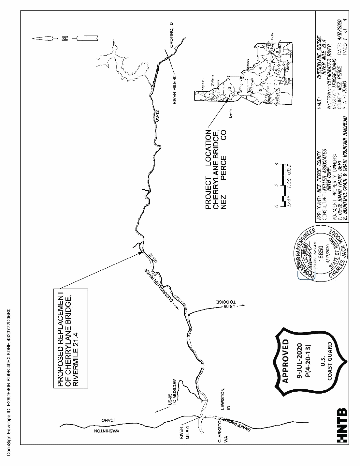
Example 2 – Location and Vicinity Map

Example 3 – Location and Vicinity Map (International Bridge)
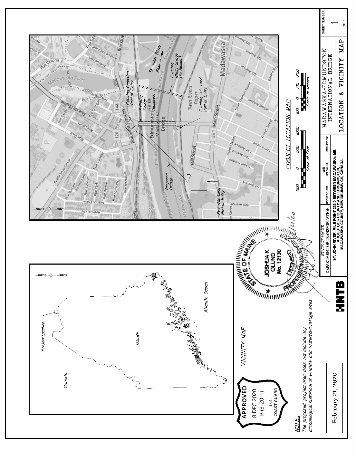
Example 4 – Plan View
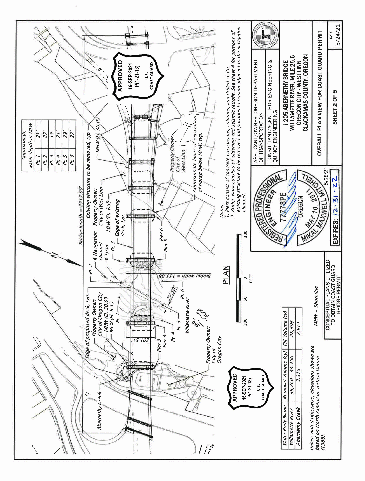
Example 5 – Plan View
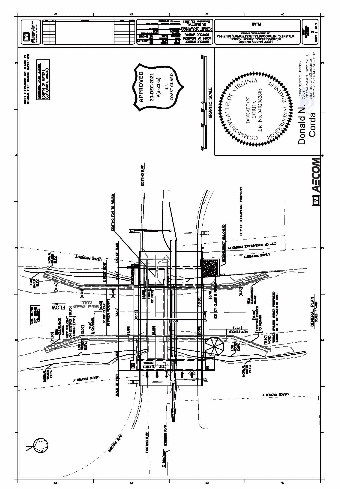
Example 6 – Plan View
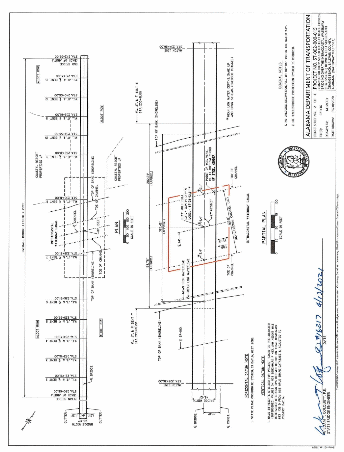 ’
’
Example 7 – Plan View with Bridge Protective System
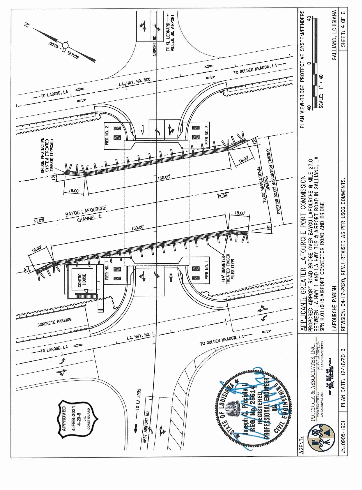
Example 8 – Elevation View
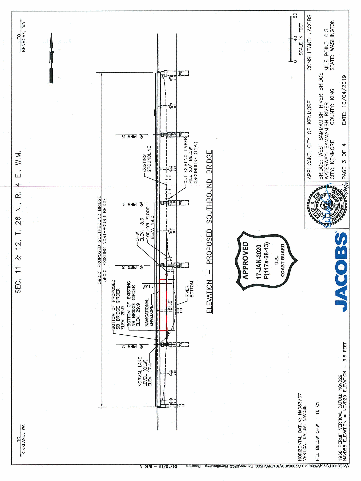
Example 9 – Elevation View
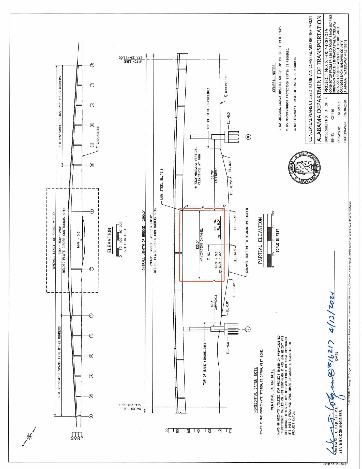
Example 10 – Elevation View Vertical Lift Bridge
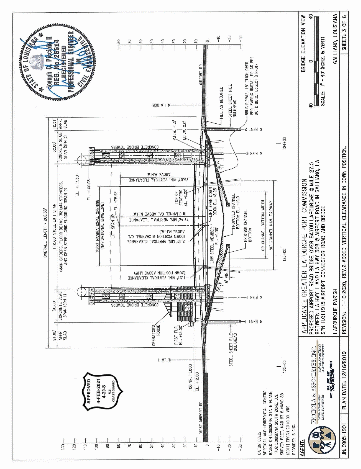
Example 11 – Elevation View Single-Leaf Bascule Drawbridge
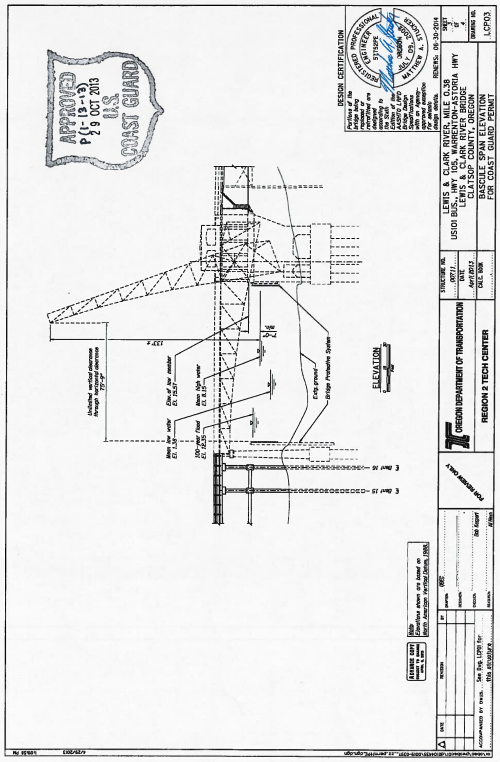
Example 12 – Elevation View Swing Drawbridge
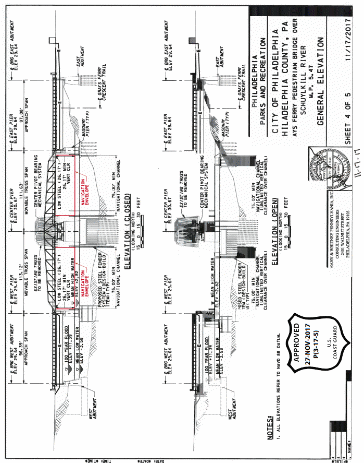
Example 13 – Combined Plan and Elevation View
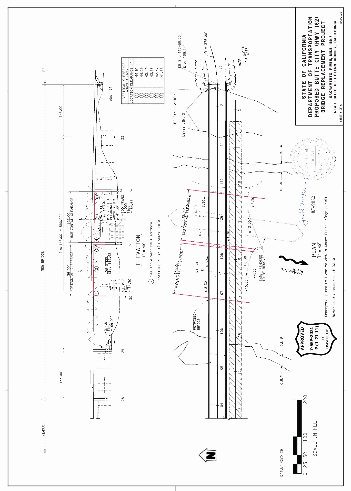
Example 14 – Combined Plan and Elevation View
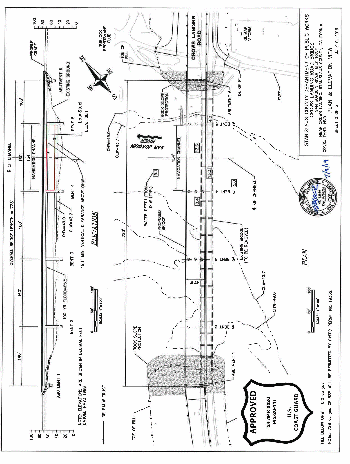
Example 15 – Combined Plan and Elevation View for Temporary Work Trestle
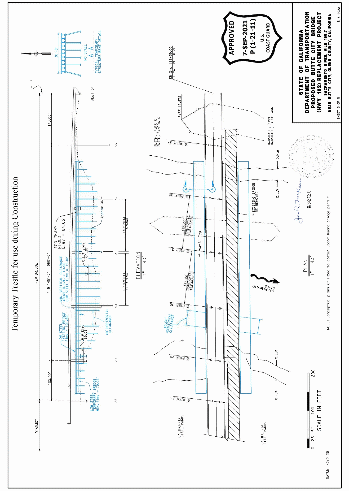
Example 16 – Combined Plan and Elevation View for Temporary Work Platform

Example 17 – Combined Plan and Elevation View for Temporary Bridge
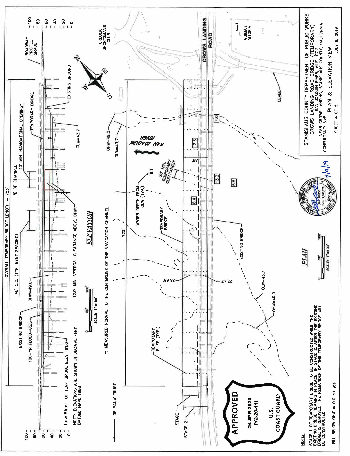
Example 18 – Typical Section View
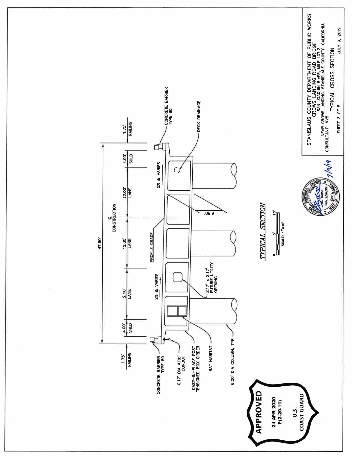
Example 19 – Typical Section View
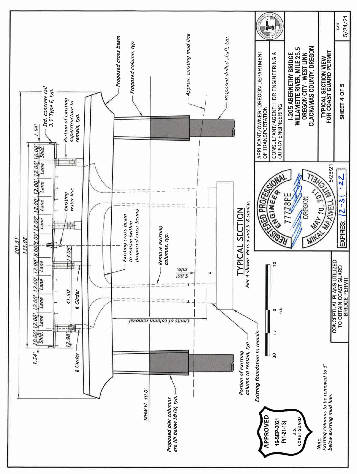
Example 20 – Typical Section View
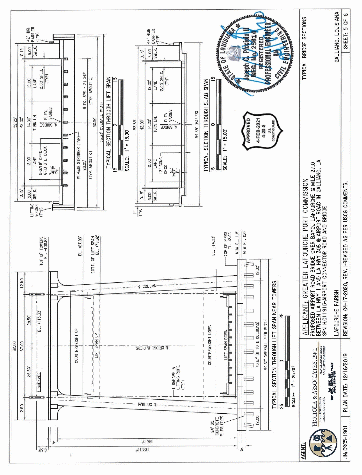
Example 21 – Elevation and Typical Section View for Bridge Protective System
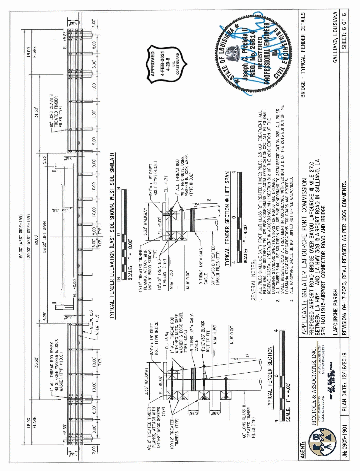
Appendix E: ENVIRONMENTAL CONTROL LAWS, EXECUTIVE ORDERS, AND REGULATIONS REQUIRING COMPLIANCE, AS APPLICABLE, WITH BRIDGE PROGRAM ACTIONS
UNITED STATES CODE REFERENCES |
IMPLEMENTING REGULATIONS |
BRIDGE LAWS: 33 U.S.C. § § 401; 491 – 508; and 511 to 535(i) |
33 CFR PARTS 114 – 118 |
NATIONAL ENVIRONMENTAL POLICY ACT OF 1969, AS AMENDED 42 U.S.C. § 4321 |
40 CFR PARTS 1500 – 1508 |
CLEAN WATER ACT OF 1977 33 U.S.C. § § 1251; 1352; and 1330 COASTAL ZONE MANAGEMENT ACT OF 1972 16 U.S.C. § § 1451; and 3501 - 3503 COASTAL BARRIER RESOURCES ACT OF 1982 16 USC § 3501 E.O. 11990 - EXECUTIVE ORDER ON PROTECTION OF WETLANDS E.O. 11988 - EXECUTIVE ORDER ON FLOODPLAIN MANAGEMENT AND PROTECTION |
40 CFR PART 121 Water Quality Certification 40 CFR PARTS 401-503 and 136 15 CFR PART 930
DOT Order 5620.2 Floodplain Management |
NATIONAL HISTORIC PRESERVATION ACT OF 1966, SECTION 106 16 U.S.C. § 470 |
36 CFR PARTS 60, 63, and 800
|
FISH AND WILDLIFE COORDINATION ACT 16 U.S.C. § 661 - 666 ENDANGERED SPECIES ACT OF 1973 16 U.S.C. § 1531 MARINE MAMMAL PROTECTION ACT OF 1972 |
50 CFR PART 17
50 CFR PART 402
50 CFR PART 216 |
LAND AND WATER CONSERVATION FUND ACT OF 1965: 16 U.S.C. § 4601-4604 et seq. |
36 CFR PART 59 |
Environmental Control Laws, Executive Orders, and Regulations Requiring Compliance, as applicable, with Bridge Program Actions |
|
UNITED STATES CODE REFERENCES |
IMPLEMENTING REGULATIONS |
NATIONAL MARINE SANCTURIES ACT 16 U.S.C. § 1431 MAGNUSON – STEVENS FISHERY CONSERVATION AND MANAGEMENT ACT (Essential Fish Habitat) 16 U.S.C. § 1855 MIGRATORY BIRD TREATY ACT OF 1918 16 U.S.C. § 703 – 712 BALD AND GOLDEN EAGLE PROTECTION ACT E.O. 13112 - EXECUTIVE ORDER ON INVASIVE SPECIES E.O. 13186 - EXECUTIVE ORDER ON RESPONSIBILITIES OF FEDERAL AGENCIES TO PROTECT MIGRATORY BIRDS |
15 CFR PART 922
50 CFR PARTS 600.805 - .930
50 CFR PART 10 and 21
|
CLEAN AIR ACT 42 U.S.C. § § 7401, 7410 and 7506(c) |
40 CFR PARTS 6, 51 and 93 |
WILD AND SCENIC RIVERS ACT OF 1968 16 U.S.C. § 1271 – 1287 |
36 CFR PART 297 |
E.O. 12898 - EXECUTIVE ORDER ON ENVIRONMENTAL JUSTICE |
|
RESOURCE CONSERVATION AND RECOVERY ACT 42 U.S.C. § 9601 |
40 CFR PARTS 239-282 |
E.O. 12114 - EXECUTIVE ORDER ON ENVIRONMENTAL EFFECTS ABROAD OF MAJOR FEDERAL ACTIONS |
|
COMPREHENSIVE ENVIRONMENTAL RESPONSE, COMPENSATION AND LIABILITY ACT OF 1980 42 U.S.C. § 103 |
40 CFR PARTS 300 – 374 |
Appendix F: Coast Guard Lead Federal Agency Environmental Assessment / Environmental Impact Statement Documentation Requirements
When the Coast Guard is identified as the Lead Federal Agency (LFA) for the National Environmental Policy Act (NEPA), either the local Coast Guard District Bridge Office or the applicant prepares the environmental document when it is determined either an Environmental Assessment (EA) or Environmental Impact Statement (EIS) is needed. When developing Coast Guard EAs or EISs, the document at a minimum should identify the following when addressing each environmental control law, regulation, or Executive Order.
The Coast Guard also uses this checklist to verify another LFA's NEPA document to ensure it meets Coast Guard needs for potential adoption of pertinent sections when the Coast Guard is not the LFA.
NATIONAL ENVIRONMENTAL POLICY ACT OF 1969 (NEPA)
42 U.S.C. § 4321 / CFR Parts 1500 – 1508
Identify the date of EA/EIS.
Provide a brief description of proposed action.
Provide a statement of purpose and need for proposed action.
Provide a citation that a USCG permit is needed.
Identify the alternatives considered, including the proposed action.
Provide a description of alternatives, including the proposed action and no-action in comparative form.
Describe the Site History.
Identify the Lead Federal Agency.
Identify any Cooperating Agencies for project.
State whether the EA or EIS has been modified, reevaluated, supplemented or rescinded for the proposed action.
NEPA MITIGATION – USCG LEAD FEDERAL AGENCY ONLY
The EA/EIS must contain a mitigation matrix or table. This may be documented in a separate chapter.
Identify any mitigation commitments including compensatory mitigation.
Provide a description of the anticipated benefit of the mitigation. Environmental planning documents must identify those measures that result from regulatory compliance requirements such as Endangered Species Act consultation or Marine Mammal Protection Act permitting.
Identify the criteria for evaluating the efficacy of mitigation applied to avoid significance or reduce the severity or intensity of the impacts of an action.
Describe how the mitigation measures will be implemented and monitored.
Identify assignment of command/program responsibility for implementing mitigation measures and determining their effectiveness (i.e. through monitoring).
Identify the estimated completion date for implementation of the mitigation, as applicable.
E.O. 12114 - ENVIRONMENTAL EFFECTS ABROAD
Does the proposed project involve a bridge connection to Canada or Mexico?
If yes, include any Council on Environmental Quality (CEQ) and U.S. Department of State (DOS) comments, as appropriate.
CLEAN WATER ACT OF 1977
33 U.S.C. § § 1251; 1352; and 1330 / 40 CFR Part 121 Water Quality Certification /
40 CFR Parts 401-503 and 136
Provide a description of water resources.
Discuss impacts to water resources from the proposed bridge construction or modification including the possibility of in-water work and the discharge of dredge materials or fill into waters of the US including, rivers, streams, and wetlands.
State whether Water Quality Certification (WQC) is required and the status of the WQC application (if applicable).
State whether a Clean Water Act Section 404 permit is required and the status of the 404 permit.
Discuss mitigation measures.
Include consultation and coordination (letters, meeting minutes, reports). EPA comment, if applicable.
E.O. 11990 - PROTECTION OF WETLANDS
Provide a description of wetlands.
Discuss impacts to wetlands (temporary and permanent) from bridge.
Discuss mitigation measures.
Include consultation and coordination (letters, meeting minutes, reports) with USACE if mitigation measures are taken.
COASTAL ZONE MANAGEMENT ACT OF 1972
16 U.S.C. § § 1451; and 3501 – 3503 / 15 CFR Part 930
State if project is within boundaries of State(s) CZM Program.
Identify State(s) Coastal Zone Management (CZM) Program, if applicable.
Certify that project is consistent with CZM program(s).
State concurrence for CZM, if applicable.
E.O. 11988 - FLOODPLAIN MANAGEMENT AND PROTECTION
DOT Order 5620.2 Floodplain Management
State if project is located in the base floodplain.
Provide the 100-year flood elevation.
Discuss impacts of bridge project on floodplains.
Identify any consultation and coordination (letters, meeting, minutes, reports) with FEMA.
WILD AND SCENIC RIVERS ACT OF 1968
16 U.S.C. § 1271 – 1287 / 36 CFR Part 297
Identify if the river involved in the proposed bridge project a designated Wild and Scenic River segment or listed on the Nationwide Rivers Inventory.
If yes, discuss impacts to the river segment, mitigation, and other compliance with Section 7 of the Wild and Scenic Rivers Act of 1968 (including correspondence with the river-administering agency).
COASTAL BARRIER RESOURCES ACT OF 1982
16 USC § 3501
Identify if the proposed project connects to a unit of the Coastal Barrier Resources System.
If yes and the project is federally funded, discuss impacts to the coastal barrier resource, mitigation, and includes Section 6 exception and coordination with FWS.
LAND AND WATER CONSERVATION FUND ACT OF 1965
16 U.S.C. § 4601-4604 et seq. / 36 CFR Part 59
State if the project will require a conversion of land funded by the LWCFA.
Identify any correspondence with the NPS, State Liaison Officer (SLO), and authorization from the Secretary of the Interior, if applicable.
NATIONAL MARINE SANCTURIES ACT
16 U.S.C. § 1431 / 15 CFR Part 922
State if the proposed project is in or adjacent to a National Marine Sanctuary or Marine Protected Area.
If so, identify if the proposed bridge is likely to destroy, cause loss of, or injure a resource of a National Marine Sanctuary. If so, include a sanctuary resource statement.
Provide mitigation measures and correspondence with NOAA’s ONMS or the relevant MPA.
When applicable, include consultation and coordination (letter of authorization) with NMFS.
ENDANGERED SPECIES ACT OF 1973
16 U.S.C. § 1531 / 50 CFR PART 402
Provide a description of endangered, threatened, and candidate species, and critical habitat.
Discuss impacts to endangered, threatened, and candidate species, and critical habitat.
Provide date of Biological Assessment (separate or included in NEPA document).
Provide mitigation measures.
Identify the consultation timeline with FWS and/or NMFS.
Provide relevant correspondence with USFWS/NMFS (Review the Final EA or EIS for the concurrence, if not final at this point).
MAGNUSON – STEVENS FISHERY CONSERVATION AND MANAGEMENT ACT (ESSENTIAL FISH HABITAT)
16 U.S.C. § 1855 / 50 CFR Parts 600.805 - .930
Provide a description of Essential Fish Habitat (EFH).
Discuss impacts to EFH from proposed bridge.
Provide any mitigation measures.
Include any consultation and coordination (letters, meeting, minutes, reports) with the NMFS.
FISH AND WILDLIFE COORDINATION ACT
16 U.S.C. § 661 – 666 / 50 CFR Part 17
Provide a description of fish and wildlife.
Discuss impacts to fish and wildlife.
Discuss mitigation measures.
Include any correspondence with USFWS and the relevant state wildlife agency(ies) regarding FWCA coordination.
MARINE MAMMAL PROTECTION ACT OF 1972
50 CFR PART 216
Provide a description of marine mammals.
Discuss impacts to marine mammals.
Identify if the proposed project involves a “take” of marine mammals?
Discuss mitigation measures.
Include any correspondence with NMFS and/or USFWS.
MIGRATORY BIRD TREATY ACT OF 1918
E.O. 13186 - RESPONSIBILITIES OF FEDERAL AGENCIES TO PROTECT MIGRATORY BIRDS
16 U.S.C. § 703 – 712 / 50 CFR Parts 10 and 21
Provide a description of migratory birds.
Discuss impacts to migratory birds.
Identify if the project involves a potential take of migratory birds?
State if a permit from USFWS is required.
Discuss any mitigation measures.
Include any correspondence with USFWS if a permit is required.
BALD AND GOLDEN EAGLE PROTECTION ACT
Provide a description of eagles in the project area.
Discuss impacts to eagles.
Identify if the proposed project will take or disturb bald or golden eagles (including nests).
State if a permit from USFWS required.
Include any correspondence with USFWS.
E.O. 13112 - INVASIVE SPECIES
Provide a description of invasive species.
Discuss any impacts to invasive species and their spread.
Discuss mitigation measures.
NATIONAL HISTORIC PRESERVATION ACT OF 1966, SECTION 106, AND CULTURAL AND HISTORCI RESOURCES
16 U.S.C. § 470 / 36 CFR PARTS 60, 63, and 800
Provide a description of historic, archaeological, and cultural resources.
Discuss impacts to historic, archaeological, and cultural resources.
Discuss mitigation measures.
If the project has potential to impact Section 106 properties, provide evidence of consultation with the State Historic Preservation Officer (and the Advisory Council on Historic preservation, if applicable).
Identify the date of any Memorandum of Agreement (MOA), if applicable.
If project is located on federal or Native American land, provide compliance with Archeological Resources Protection Act of 1979 (ARPA) and/or Antiquities Act of 1906.
If project involves collection of human remains, funerary objects, sacred objects, or other similar objects associated with Tribal Nations and native Hawaiian organizations, provide compliance with the Native American Graves Protection and Repatriation Act and the American Indian Religious Freedom Act of 1978.
If project involves the disturbance or destruction of shipwrecks located on state submerged lands, provide compliance with the Abandoned Shipwreck Act of 1987.
CLEAN AIR ACT
42 U.S.C. § § 7401, 7410 and 7506(c) / 40 CFR Parts 6, 51 and 93
Provide a description of air quality in the project area.
Discuss impacts from construction and operation.
Discuss mitigation measures.
State whether the project is in an area of attainment, maintenance, or nonattainment for each of the criteria pollutants in the NAAQS.
If project occurs in a nonattainment or maintenance area, state if the transportation or general conformity regulations, or both, apply.
If applicable, provide exemption(s) from a transportation conformity analysis for any of the reasons listed in 40 CFR 93.126 and provide the reason.
If applicable, provide exemption(s) from a general conformity analysis for any of the reasons listed in 40 CFR 93.153(c) and provide the reason.
If transportation conformity applies, discuss if the project listed in a conforming SIP, FIP, TIP, and/or RTP.
E.O. 12898 - ENVIRONMENTAL JUSTICE
Discuss impacts to minority or low-income populations and determines whether those impacts are disproportionately adverse.
Discuss mitigation measures.
Include the Interagency Working Group on Environmental Justice comment, if applicable.
COMPREHENSIVE ENVIRONMENTAL RESPONSE, COMPENSATION AND LIABILITY ACT OF 1980 (CERCLA)
42 U.S.C. § 103 / 40 CFR Parts 300 – 374
RESOURCE CONSERVATION RECOVERY ACT (RCRA)
40 CFR Parts 239 – 282
HAZARDOUS MATERIALS, SUBSTANCES, OR WASTES
Provide a description of contaminated sites.
Discuss compliance with Comprehensive Environmental Response, Compensation and Liability Act (CERCLA), Resource Conservation and Recovery Act (RCRA) or State law regulating hazardous materials, substances, or wastes.
APPENDIX G: COAST GUARD DISTRICT BRIDGE PROGRAM OFFICE CONTACTS
-
Commander (dpb)
First Coast Guard District
Battery Park Building
New York, NY 10004-1466
Tel: 212-514-4331Commander (dpb)
Ninth Coast Guard District
1240 East 9th Street
Cleveland, OH 44199-2060
Tel: 216-902-6087Commander (dpb)
Fifth Coast Guard District
LANTAREA
Federal Building
431 Crawford Street
Portsmouth, VA 23704-5004
Tel: 757-398-6222Commander (dpw)
Eleventh Coast Guard District
Building 50 - 6
Alameda, CA 94501-5100
Tel: 510-437-3516Commander (dpb)
Seventh Coast Guard District
909 SE First Avenue (Ste 432)
Miami, FL 33130-3050
Tel: 305-415-6743Commander (dpw)
Thirteenth Coast Guard District
Jackson Federal Building
915 Second Avenue
Seattle, WA 98174-1067
Tel: 206-220-7282Commander (dpb)
Eighth Coast Guard District
Hale Boggs Federal Building
501 Magazine Street
New Orleans, LA 70130-3396
Tel: 504-671-2127Commander (dpw)
Fourteenth Coast Guard District
Prince Kalanianaole Federal Bldg
300 Ala Moana Blvd., Rm. 9139
Honolulu, HI 96850-4982
Tel: 808-535-3412Commander (dwb)
Eighth Coast Guard District
1222 Spruce Street
St. Louis, MO 63103-2398
Tel: 314-269-2378Commander (dpw)
Seventeenth Coast Guard District
P. O. Box 25517
Juneau, AK 99802-5517
Tel: 907-463-2268
Appendix H: COAST GUARD DISTRICT MAP

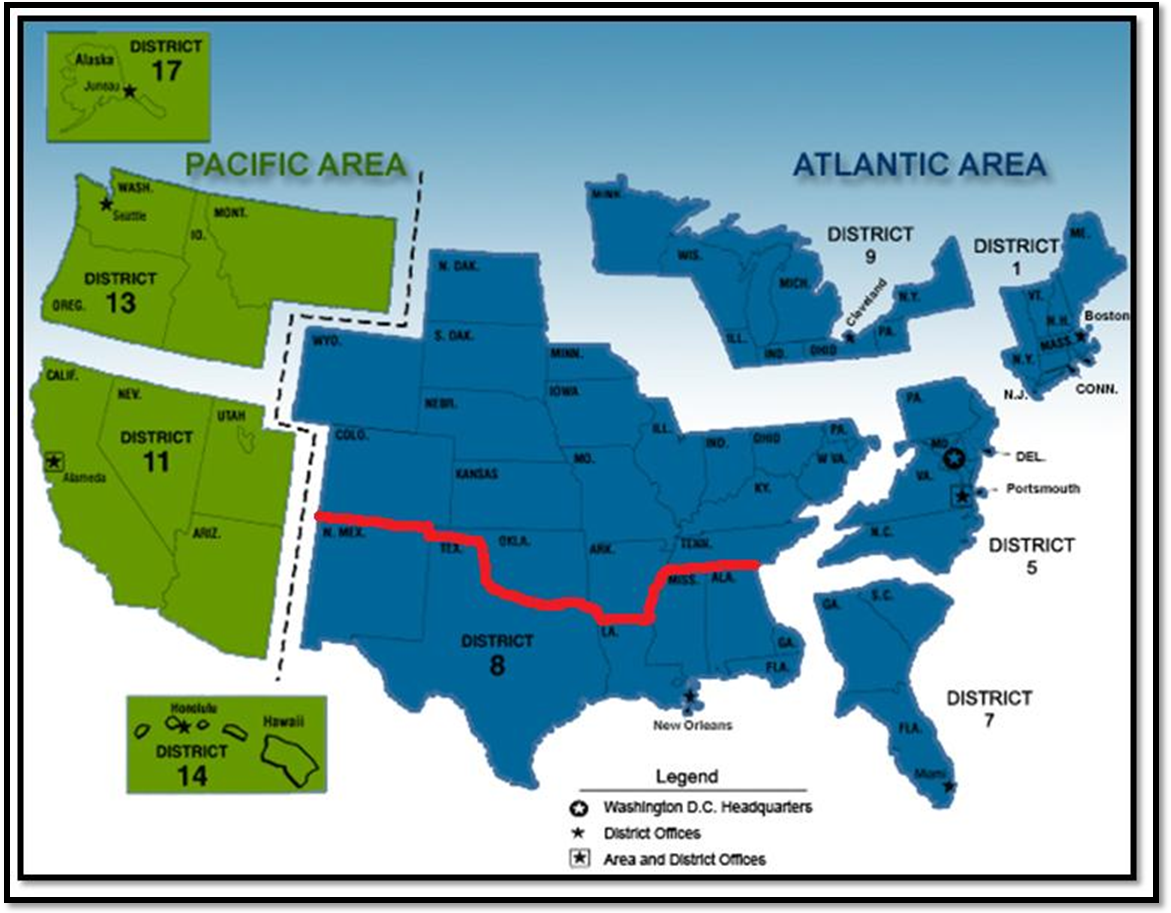
District
8
District
8 New Orleans (Gulf)
District
8 St. Louis (Western
Rivers)
Appendix I: BRIDGE LIGHTING GUIDE
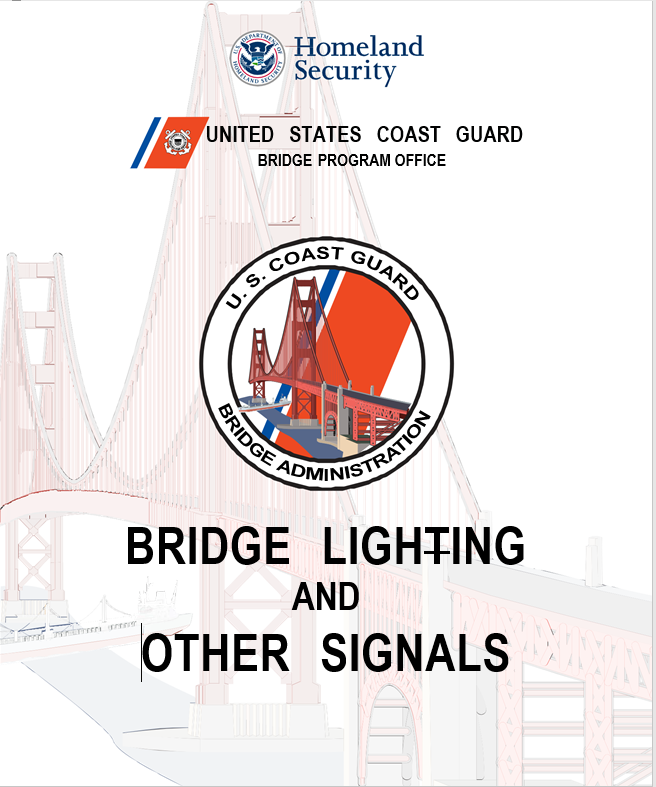

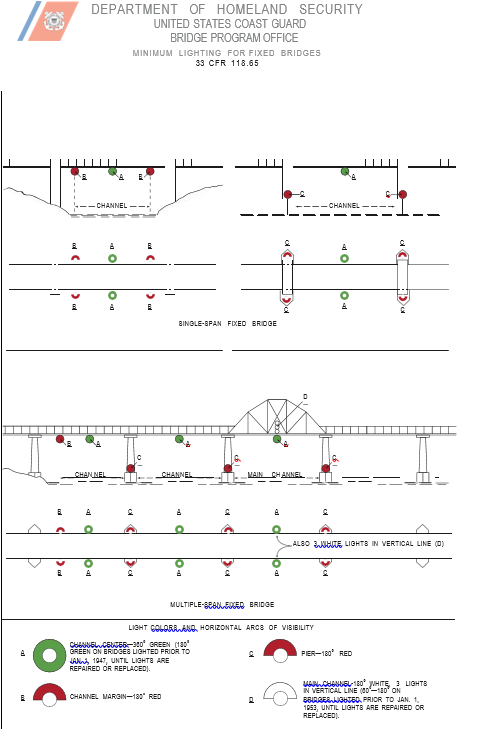
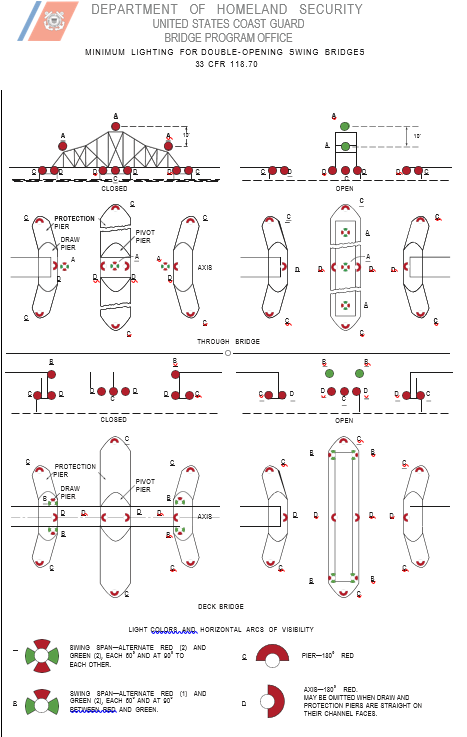
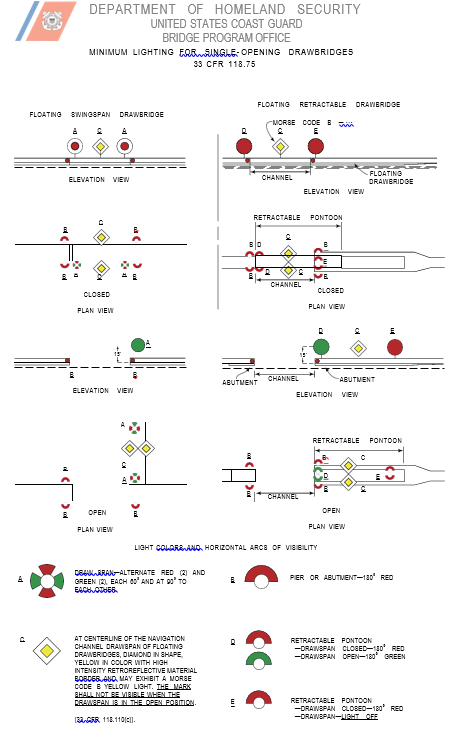
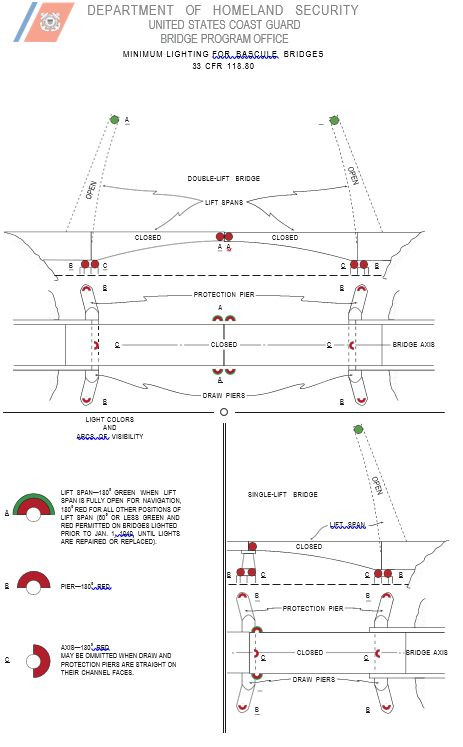

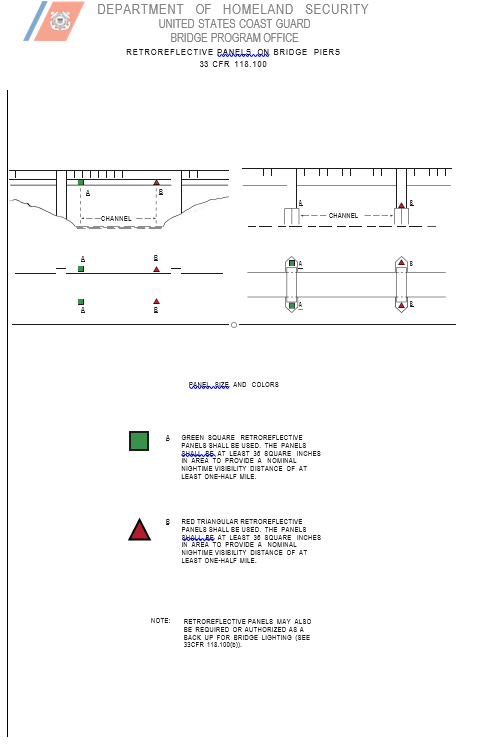
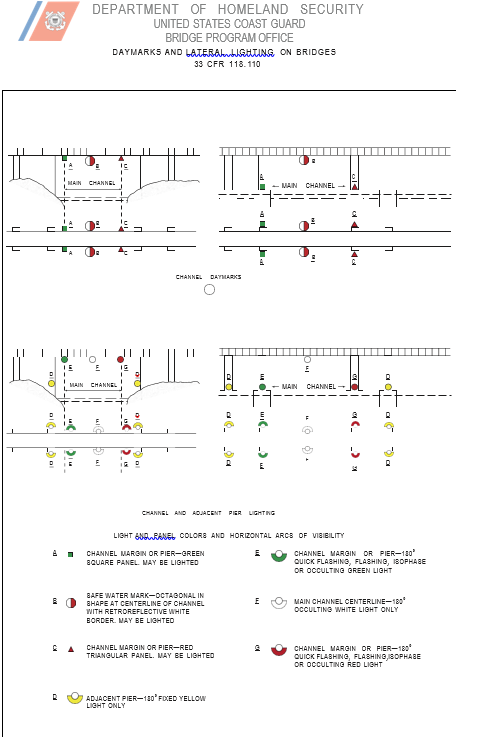
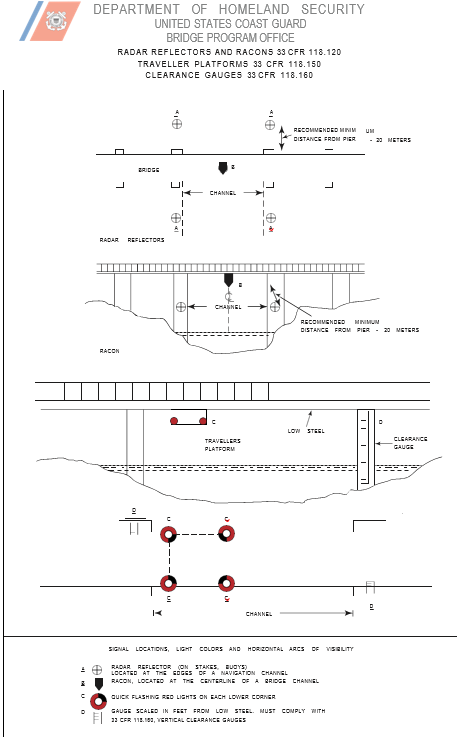
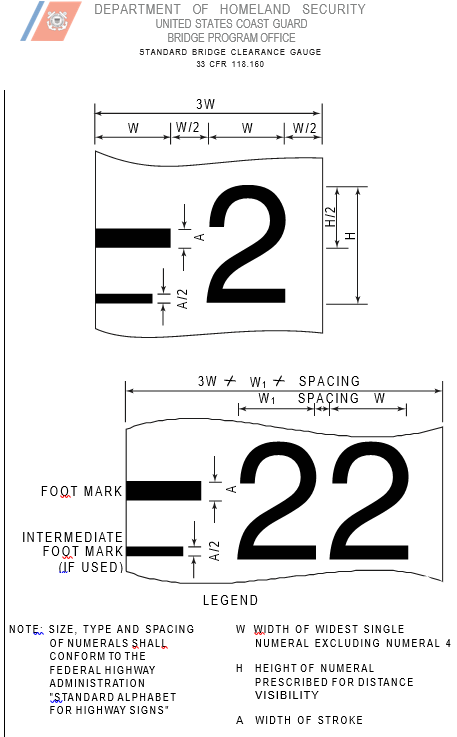

| File Type | application/vnd.openxmlformats-officedocument.wordprocessingml.document |
| File Title | U&Depcrtment..Commandant. MAILING AODF |
| Author | Garneau, Allen M CIV USCG BASE NCR (USA) |
| File Modified | 0000-00-00 |
| File Created | 2024-07-20 |
© 2025 OMB.report | Privacy Policy